#however some people base their 'project' around the tools they aim to use because they enjoy using that tool
Explore tagged Tumblr posts
Text
75 AI Powered Design Tools to Boost Your Productivity in 2023

Ummm, yeah. There's always a catchy buzzword circling around when it comes to technology and the internet. And if you are somehow related to emerging developments, you can't escape from these buzzwords. Over the years, we have seen many buzzwords come and go. Big data, virtual reality, augmented reality, smartphone adoption, mixed reality, drones, trendy social media platforms, project mapping, machine learning, deep learning, blockchain, web3, NFTs, and now we are living in the Artificial Intelligence (AI) era. All these terms had their moment in the tech-savvy world but eventually, they matured and hit their plateau. And now we will dive into AI design tools to show you an glipmse of AI's capabilities. The term AI isn't new in the tech bubble. Honestly, people named any machine learning or deep learning project as artificial intelligence since it's easier to explain to the masses. But we saw a massive shift in the AI paradigm in just two years. Previously, AI was used to categorize mass data, create social media filters, pattern prediction, or similar types of operational tasks. However, two products changed the way we see AI and its capabilities. Dall-E affected visual creation by only using prompts, and ChatGPT handled what's left with text-based, conversational assistance about any topic. Dall-E and ChatGPT are the most popular products of OpenAI. On the other side, countless small or mid-sized teams are creating their own AI-powered products, while other tech giants like Adobe, Google, Microsoft, NVIDIA, Shutterstock, and many more follow up with the AI hype train. Now it's our turn to aim to make one of the most valuable AI design tools to benefit you and your creative process. This list obviously will not be a database of every tool. But it's more like a collection of handy options filtered from the noise. Because in just seven days, there were more than 360 AI tools released. In this list, some tools provide free plans, but some are freemium or require payment to benefit. Reach out to us if you suggest any additions to the list!
Writing And Text-based Conversational AI Tools
ChatGPT and GPT-4 are among the most popular and well-known text-based conversational tools. They can handle pretty much anything a user can imagine and turn that idea into a prompt. There are countless use cases to leverage ChatGPT in many areas such as marketing, content writing, SEO, organizing spreadsheets and creating formulas, data analysis, and creating scripts in Python, JavaScript, C++, C#, Ruby, PHP, SQL, and so on. I have also seen people asking questions like "build me a company with zero capital and create a business plan about that idea." Of course, ChatGPT isn't the only tool that allows you to interact with text. There are countless projects, startups, and teams that create AI-based tools that produce texts for various needs. But their common points are more or less the same. Most of them provide a freemium plan, which you can use for free, but you'll have to pay to unlock some key features. Also, providing a detailed prompt is key to benefiting from their capabilities according to your needs. Lastly, many of them are great companions, but they still need an extra human touch to make the output presentable. - ChatGPT and GPT-4 - Jack of all trades and the perfect starting point for text based AI tools. - Copy.ai - AI based content writer for blogs, social media and newsletters. - Copysmith - Focused on product and commerce, can provide specific product descriptions. - editGPT - Easily proofread, edit, and track changes to your content in chatGPT. - Jesper - Quick and fast content writer. - Markcopy - AI writer tool focused on SEO. - Quillbot - AI based paraphraser, plagiarism checker and more. - Rytr - Writing assistant. - Simplified - Marketing focused writer with the free AI copywriting generator. - Wordtune - Describe your thoughts and tool sophisticatedly rewrites them.
AI Design Tools
Design is at the center of our daily lives, and it's crucial to keep up with the developments, as there seems to be a new tool every other week to help designers and artists. Countless AI tools are available for designing, including image generators, object and background removers, icon creators, logo generators, and more. We categorized our findings and grouped them by their main purpose to analyze them more accurately, but there will always be outliers. Therefore, we are starting with them first. - Booth.ai - Creates professional looking product photography with AI - Designs.ai - Creates text, video, logo, mockup, social media posts and voiceover. - Magician for Figma - Figma addon which creates icons, text and image - Pebblely - AI based product photography and placement tool. - Stylized.ai - Product imagery with integration to e-commerce platforms - UIzard.io - All around design tool for non-designers and anyone interested.
AI Generated Images
Image generation with artificial intelligence has become mainstream in our daily lives with tools like Dall-E. We have been training AI with tools like reCAPTCHA for some time, so people have been exposed to things generated by artificial intelligence. But today's image generation tools are light years ahead of what we had just a few years ago. They have been trained on countless images and can now create specific images based on written descriptions. Dall-E, Stable Diffusion, and Midjourney are the biggest players in the field, but the market is growing, so everyone can have a bigger slice. Also, let's not forget the ongoing conversation about datasets and artists' rights to opt-out or give their consent before training AI models. Since all AI models are trained using large volumes of data, and when it comes to images, they use various sources to obtain datasets. Some applications and platforms have used artists' works to create similar visual styles without their notification or consent. So let's keep that in mind while exploring new tools on the internet. - Dall-E 2 - Latest image generator from Open AI, which is one of the most capable tool in this vertical. - Image Creator from Microsoft Bing powered by Dall-E - Bing integrated AI tools developed by Open AI. This one is an image creator using text based prompts. - Midjourney - is one of the big three text-to-image model in current AI field. Can be used on their Discord server. - Stable Diffusion - One of the most popular deep learning, text-to-image model in the field. - Adobe Firefly - Generative AI tool integrated in all Adobe products, developed by Adobe. - Canva Text to Image - Canva's step into image generation. - Imagen - a text-to-image diffusion model created by Google. - Make-A-Scene - is a multimodal generative AI method by Meta. - NVIDIA Canvas - uses AI to turn simple brushstrokes into realistic landscape images. - AI Image Generator - an image generator by Shutterstock. - Runway - Easily creates an image from scratch by entering descriptive text.
Stable Diffusion Based Tools
- Alpaca - Stable Diffusion Photoshop plugin. - Diffusionbee - Stable Diffusion based stand alone macOS app. And it works offline. - Lexica.art - Stable Diffusion search engine - Lexica Aperture - Generates photorealistic images. - The Stability Photoshop Plugin - Works in Adobe Photoshop using Stable Diffusion and Dall-E together.
Color Palettes
Another AI design tools vertical is color palettes. They are capable to create color schemes based on one color, reference or screenshot. - Colormind - is a color scheme generator that uses deep learning. - ColorGPT - Generating color name captured from real-world using AI - Huemint - uses machine learning to create unique color schemes for your brand, website or graphic - Khroma - The AI color tool for designers
Photo Editing
There are AI design tools available for almost every tool in Adobe Photoshop. These tools are specifically designed for a particular feature and are available in both free and freemium models. For instance, some tools are designed to take old, grainy photos and restore their resolution, while others can remove objects or people from an entire image and create a transparent version of it. Additionally, some tools can enlarge low-resolution images and provide high-resolution versions of them. These tools aim to provide simple solutions to common design problems. - Clipdrop - AI design tool which has many tools; text and background remover, image upscaling, cleanup, and more. - Colorizer - Old image restoration by colors, quality, retouching and repair. - Facet AI - can refine, auto mask, and batch edit images. - Palette.fm - Colorize images freely and without sign up. - Photoroom - can handle simple tasks such as removing, blurring backgrounds and retouches. - Restore Photos - Old image restoration.
Background Remover
- BG.Eraser - Background and object eraser. - bgsub - Automatically replaces the background with other images. - Erase.bg - Free background remover. - Green Screen AI - Changes the background of an image. - Hama - Erases people or objects from an image. - Remove bg - Free and automatic tool. - Unfake.png - Detects fake PNG files and remove the fake grid layout. - Visio Stuido - Self-claimed advanced background removal tool.
Image Enlarger
- AI. Image Enlarger - Image enlarger and enhancer tool. - bigjpg - Increases the resolution of images. - Let's Enhance - Automatic AI editor to increase image resolution without losing quality. - Upscale - is a free tool to upscale and enhance images - Vance.AI - Free and online image upscaler
Video Producing
Video production is the last part of our approach to three-main-pillars of multimedia. There are also many tools in audio editing, marketing, coding, and more categories, but we exclude these to keep the focus on a designer's perspective. You can find some repositories at the end of the article, which we also take as a resource. And also, especially in this section, many of these tools come with a free trial version and after that time, it requires to purchase or subscription. Lastly, some of these tool are requires watermarks in their free plans.
Text-to-Video
- Elai.io Builds customized AI videos with a presenter without using a camera, studio and a green screen, offers limited free plan. - Fliki - Turns text into videos with AI voiceover. - Gen2 - is a successor of Gen1 and both of them free to use by credits. After these credits exceeded it directs users to paid plans. It is commonly recognized as one of the best in the text-to-video models. - Hour One - turns text into video, featuring virtual presenters, automatically, offers free-trial. - Movio - Turns text into spokesperson video by typing and clicking. - Pictory - Marketing focused AI video tool comes with free trial. - Synthesia - creates videos from plain text, but it only provides paid plans although it's popular and successful. - Synths Video - Article-to-video creator - Rephrase AI - convert texts into videos, and it can turn blog posts into videos with GPT-4 integration. Only paid plans available. - Visla - Visla is an all-in-one video storytelling platform that uses AI-generated content and features to help teams create high-quality videos quickly and efficiently.
Motion Capture
- Plask AI powered motion capture animation tool - Rokoko video - Free AI motion capture - Xpression Camera - Creates a real-time generative avatar for you to use in video chat and livestream.
Video Editor
- Descript - Video and audio editor, soon it will offer GPT-4 integration, has free plan. - Invideo - simplifies video creation with ready-made templates. - Lumen5 - branding and marketing focused video editor and creator, offers free plan. - Perfectly Clear Video - Enhances the videos and automatically fine-tunes the colors. - Unscreen - Background remover for videos and GIFs. - Veed.io - marketing focused easy video production tool. - Wisecut - Automatic video editor which offers free trial. Hat tip to collective and crowdsourced collections on Github and websites; these also helped our AI Design Tools curation; Awesome AI (links include ref tags), Read the full article
0 notes
Text
Joomla vs. WordPress: Which one should you choose in 2023?
It might not be challenging to choose a blogging platform. However, it is easier than choosing a content management system that can handle more complicated web projects. Joomla and WordPress have advanced functionality, but let’s compare them. These are the features that we will be comparing:
Even though casual bloggers don’t need much, they can still use WordPress. However, content management systems, which allow you to create more posts, are more serious.
WordPress remains the top choice even in this situation. However, when you consider the entire site, all its elements, and all the possibilities available, other players in this game are equally competitive. Have you heard of Joomla?
What’s Joomla?
Joomla, like WordPress, is an open-source CMS that allows you to create web content and powerful applications. Joomla has been around since 2005, making it a great WP alternative. Joomla is very similar to WordPress, but it is very different. Joomla allows for multiple database options, which is important for tech-savvy people. These features won’t be useful to those who aren’t into serious web development.
You must know the differences between Joomla CMS (the one we are referring to in this article) and Joomla Framework. Joomla Framework allows developers to create PHP-based apps without the additional features of the CMS.
Joomla is easy to use, is updated frequently, has many customization options, and is a great tool for average users. It sounds a lot like WordPress, right? Joomla, however, has been downloaded only 60 million times. This is in contrast to WordPress, which has more than 140,000,000 downloads. So, although the numbers are staggering, they’re less impressive than those of WordPress.
The following video is a comparison of older versions of WordPress and Joomla. However, the core features have not changed much. Therefore, the comparison can be used for both the older and newer CMS versions.
Easy to use
The tools should be easy to use, even if you aim to become a web designer or developer. A simple CMS is essential for novice web developers. Both Joomla and WordPress are easy to use and understand.
WordPress
WordPress is known for its easy and quick installation. Even if you’re the first user, your site will be up and running in less than five minutes. Users don’t need to spend too much time learning WordPress basics after they log in.
Everything is easy to use, and everything makes sense. Although some learning is involved, most options and menus will be within reach, so you can navigate the admin area easily. Of course, if you’re interested in WordPress beyond its simple usage, you can always return to learn WordPress development step-by-step.
Joomla
Joomla’s installation is very simple. Joomla’s installation is similar to WordPress’s, and many hosting companies offer one-click software. Sadly, the similarities end here, as Joomla is more difficult to use.
Joomla is still a popular CMS, even though it’s not as well-known as WordPress. Joomla has tens of thousands of users. So it’s not surprising that Joomla has a large community. It’s easy to find help via tutorials, articles, and videos. You can use many forums to ask for assistance, but you should start by checking the official support page.
Unlike WordPress, it is difficult to find Joomla specialists who can do different tasks for your website.
Security
If none of the CMSes are secure enough, it doesn’t matter how user-friendly they are. This is where Joomla and WordPress come in handy.
WordPress
WordPress is the most used CMS in the world. This also means that hackers are most likely to target WordPress websites. WordPress is secure. WordPress is secure because the developers ensured it was as secure as possible. You can also expect regular updates to keep the system secure.
Security is all about the person behind the site. It’s your responsibility to keep the site safe from prying eyes. WordPress users can feel more secure by adding security plugins to their CMS. There are many security plugins available that can help protect your website.
Joomla
Joomla’s security is very similar. Joomla developers are constantly working hard to update the site and fix security problems promptly. You can find great security extensions for WordPress that will help you manage your site. However, the user must be responsible for protecting his domain.
Multilingual sites
It is attractive to have a website in multiple languages. Website owners only need the content to be available in multiple languages to reach all their customers. Both Joomla and WordPress allow multilingual websites, but they act differently.
WordPress
WordPress allows you to choose your site’s language at any moment, but it does not support multilingual content. Many plugins can transform your website into a multilingual system. However, you’ll need to pay more for licences or subscriptions.
Joomla
Joomla, unlike WordPress, offers multilingual options right from the moment you install it.

Which one do you prefer?
Joomla and Wordpress are very similar at first glance. However, although they look very similar, Joomla and WordPress are indeed different enough that you can easily choose which one to use for your website.
WordPress is our overall favorite. WordPress is more accessible to beginners and allows you to build more complicated websites. WordPress makes it easier to develop your system because you can access a large repository of plugins and themes. Hiring maintenance services and professional designers and programmers is much easier since more people are devoted to WordPress than Joomla.
Joomla, on the other hand, is more complex and has more features. Joomla allows professionals to create more complex websites by offering technical options from the beginning of the Website Development Company. However, these same options can unnecessarily confuse novices. Therefore, Joomla is not as well-suited for casual blogging.
#app development#ios app development#app developing company#website development company#iot development services
0 notes
Text
[R]ed [E]xodus [D]evelopment #1

Thematically appropriate music to listen to while you read
WTF is Red Exodus?
Red Exodus is a VRChat game currently in the planning/pre-pre-alpha development stage. The current concept of the game is somewhat of a mix between Escape from Tarkov and Insurgency. I'm currently working on fleshing out all the major lore and gameplay features idea-wise. I'll go ahead and plug the official (uncompleted) Discord <- HERE at the top if the rest of this post intrigues you.
Lore?
Yes, lore! I want lore to play a major role in both the visual design and story development for Red Exodus. Currently the plot revolves around the collapsed Russian City of New Pheonix.
New Pheonix was founded in 1983 after a cold-war gone hot scenario in which the United States emerged victorious. The US attempted to inject Russia with American culture through the development and investment in a major population center with the purpose of acclimating Russia to Western influence, along with other cultural subversion tactics.
In 2046 the US officially abandoned the projects due to increasingly violent attacks from a Russian loyalist group called The Sons of Russia. The city fell into lawlessness and multiple factions are now constantly vying to regain control of it. The factions are as follows.
THE IRON BRIGADE
A United States military remnant that now operates as faux-mercenaries and glory seekers. They try to maintain the grip that the puppet government once had on the city, though without the backing of the United States (on the books, anyway), they've only been partially successful. They've been known to operate work camps in the city for people unlucky enough to be prosecuted by their flimsy internal legal system.
THE SONS OF RUSSIA
A Russian loyalist insurgent group made up largely of ideological extremists, former Russian PMC's, and people upset by the desecration of Russian culture. They're known for extremely violent and deadly attacks that more often than not result in civilian collateral damage, which they see as a necessary means to an end.
RUBY'S RANGERS
Ruby's rangers is a civilian defense force that encapsulates numerous sects of survivors that aim to rebuild and re-establish order. Due to the decentralized nature of their command structure they're largely unsupervised and most missions are undergone at the behest of individuals who see something that needs done rather than any proper orders. Unfortunately they're less effective at maintaining order than they'd like to be, and zones under the protection of the Rangers often fall into chaos and lawlessness because of a lack of clear direction and ideological infighting.
DEVELOPMENT
I'm currently in the initial stages of setting up basic gameplay systems. Gunplay and map design will come first to pave the way for a smooth experience in all other aspects. Guns will be using MMMaellon's p-shooter system, which gives me a good base to work on. Current planned features include looting and crafting (traps, upgrades, tools, weapons), a persistent save-state system, NPC's, and each faction will be playable with unique missions, rewards, and gear. I'm also reaching out to see if I can find someone to make some avatars and NPC models.
What's being worked on so far?
So far focus has been put on getting the first art pass of the map done, as well as establishing the technical basis for the environment. A day/night system is in place, as well as atmospheric particle systems to give everything a more polished feel in these early stages. The pictures you see here are the result of roughly a weekend of fast paced map prototyping. Currently focus is being put on the more industrial area of the map, whereas the more bustling well lit downtown area will receive its art passes over time as I complete the custom models for the area. Most of these assets come from unity store packages, however over time I do plan on replacing most or all of these with custom modeled assets. The central building in these pictures that the courtyard surrounds is the first of many custom buildings I'd like to make for this project, each of them will have fully modeled interiors which will open up more possibilities in terms of interesting close range engagements.





CONCEPT ART
I'll be up-front about the use of generative AI like Stable Diffusion in my workflow. I take no credit for the contents of these pictures, they're collages of all the amazing artists and photographers used for the training data, if I had the names of the artists to credit here I would, but unfortunately those aren't available to me.











Don't forget to join my Discord for future updates, this will be a community-involved project! If you have any questions feel free to message me on Discord or here.
1 note
·
View note
Text
To Become with Others
A reflection on the importance of intra-action in my performance practice.
I am sitting.
I am sitting in a rehearsal space.
It’s a big space.
And it’s mostly empty.
I could…
I could…
I could do a lot of things,
here
in this big open space.
I stand up.
I walk across the room.
I try moving my body a bit.
It feels good but it’s not what I’m looking for.
I try filling the void with my voice, which feels good too, but…
But
The stakes are low.
I try writing things on big pieces of paper. I hope it will fill the vastness around me, but...
But all it does is echo the expanse of my mind. So I try moving these big pieces of paper around, my generous handwriting seems flimsy against their broadness. And sitting somewhere in all this space is the thing I’ve tried so hard to bat away, with my body or with my voice or with my writing. Thinking if I fill it, it won’t have the space to exist.
“But if I were a real artist I would know what to do."
What am I supposed to do here?
How can I best use this space for my research?
What can I uncover?
Here.
Alone.
Who am I without anyone else?
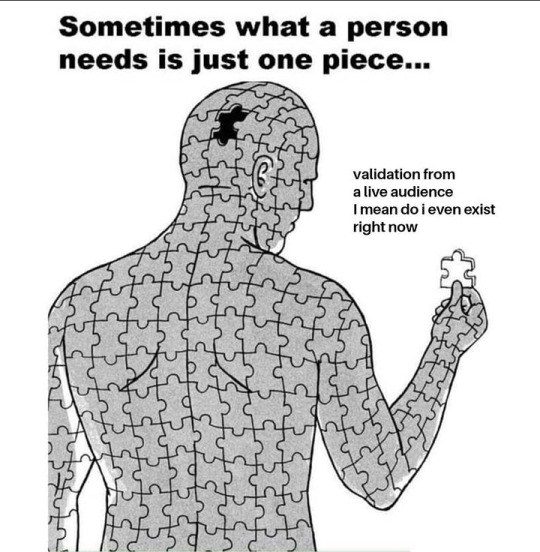
via Somatic_based_content_only on Instagram. 19.04.21
This scenario repeated itself during a workshop with Dagmar Slagmolen, director of the Amsterdam-based music theatre company, Via Berlin. Over the past few months my research has focused on vulnerability and its role in audience participation. My aim is to create a method for accessing and utilizing my own emotional vulnerability to better connect with my audience in order to enhance and expand the participatory experience. In our initial meetings, Dagmar was very excited about this project, particularly my interest in the links between shame and vulnerability. The piece I am creating in order to explore some of these techniques, focuses around my personal sexual history and hopes to buff out some of the shame which is so deeply ingrained in the patriarchal narratives surrounding sexuality in western society. In the days prior to the physical workshop, I discussed my work with Dagmar and the three other workshop participants, which helped me condense and clarify my research so far. I was then given the task of continuing to think about and experiment with vulnerability during the workshop.. Therefore, after a brief talk with Dagmar upon arriving in the studio, I was left with, none other than….. space and time to experiment.

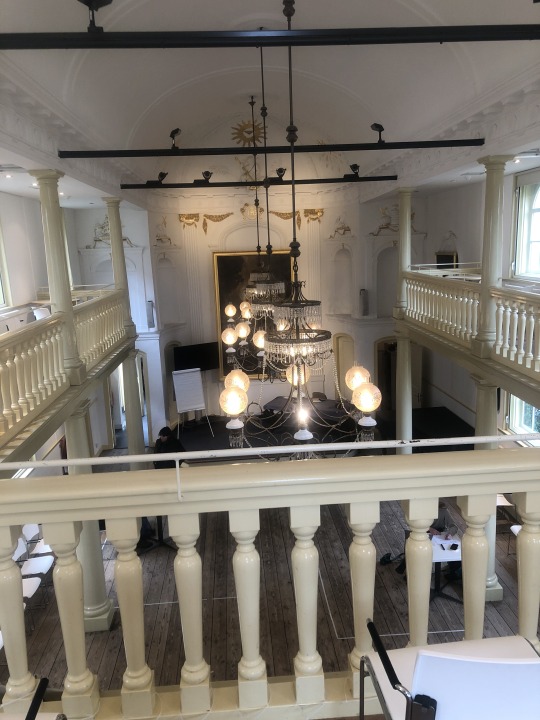
Spaces which I had time to experiment in
Sitting in this studio, I became increasingly aware of a considerable obstacle. Explore vulnerability with who? Myself? Can one even be vulnerable with one’s self? Vulnerability is an act of revealing, an act of (emotional) exposure (Brown 2012). I find this an impossibility considering the omnipresence of the self. At least for me personally, the idea of exposing my self to myself seems nonsensical, as my emotional vulnerabilities exist in relation to others. This notion of impossibility seems to parallel the more ambiguous feeling that I described in the introduction, which creeps in whenever I undergo a solo studio practice in order to create work. The work I make is not only the presentation of a skill or story or technique, but the intra-action of space, time, set parameters and most importantly, other people. While I may use studio time to learn or refine certain physical techniques, this is usually a small element of my practice. Just as I cannot experiment or rehearse my vulnerability alone due to the fact that the very notion of my vulnerability is conditional to the presence of others, so is it impossible for me to experiment or rehearse a performance which is reliant on inter and intra-actions with people around me.
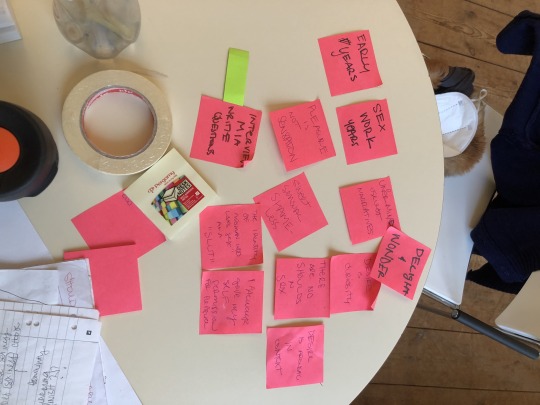
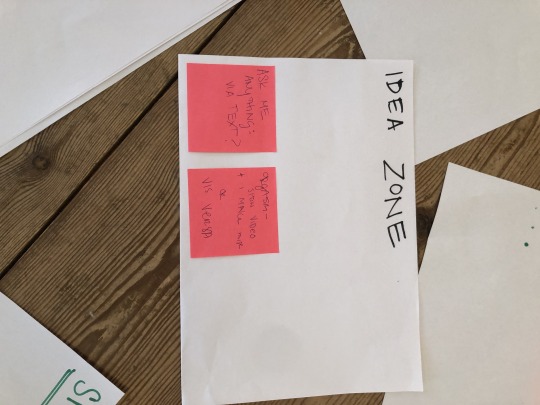
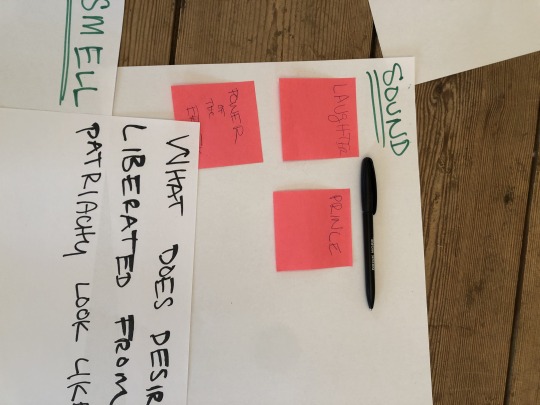

Pieces of paper, large and small
If all the world’s a stage, then when and where do we rehearse? When and where do we experiment? According to performance scholar Richard Schechner, the extended childhood particular to humans is a rehearsal, where we learn the behaviours which we ‘restore’ each day in our performance as adults (2013, 29). However, as restored behaviour may be combined and adjusted in a multitude of ways, and as our co-performers, sets and scenery are invariably interchanged, one’s performances of restored behaviour are thus in eternal flux. The performance of everyday interactions is a constant improvisation structured through certain social parameters. Each experience becomes the rehearsal for the next. It is an act of becoming, an intra-action of the players, the space, the audience etc. Scholar and physicist Karan Barad defines intra-action as “a mutual constitution of entangled agencies” (2007, 33). As I understand intra-action, it negates the idea that anything can be independent from anything else. If I think about it in the context of interactions with others, I understand that my presence and actions do not come from a self that is independent of those around me, but instead materializes through my relationships with others. Moreover, because of the multiplicitous constellations of people, places and things that come into contact throughout daily life, this diffracts into exponential infinity.
As much of my practice relies on such intra-action between myself and the other persons in the performance space, I must then question the where, how and why’s of rehearsal in my practice. Improvisation has always been wildly fulfilling to me, and even more so when I have an audience. This overused saying of ‘dance like no one's watching’ has never made sense to me. It is the eyes of others that grant me the ability to take the risks that make for an exhilarating performance. It is here where I get an embodied sense of intra-action between the audience, and myself where our relationship invokes a disassembly of any and all facades of self.

Some reflections on my relationship to improvisation as a 14-year-old
As I better understand this relationship, it also becomes clear as to why cabaret has remained at the heart of my practice. While I may wear the same costume and perform to the same music for any given act, the stage which I step on is always different, anywhere from a small piece of cleared floor with an audience member given a light with which to illuminate it, to a circus tent in the middle of a music festival as swarms of drunk people wander in after a headliner rock band. I have given myself the same task and the same tools in each however, I must remain nimble and responsive to my audience’s and surroundings. In an interview with José Esteban Muñoz, Nao Bustamante, describes a similar working method “It’s very important for me to maintain a fresh space.. I have these 12 positions that I hit within the piece… and then within those 12 positions anything can happen, and I just allow myself to watch myself, watch the audience, watch the interaction, focus on that particular moment or balance” (2002). My performance is not one of set actions, but a response (to a response to a response…) within a microcosm of intertwined energies in a room. In speaking about the work of Bustamente, Jack Halberstam writes, ‘Her body must respond on the spot and in the moment of performance to the new configurations of space and uncertainty" (2011, 144). As I have noted in previous reflections on my practice, a frequent piece of feedback I receive is along the lines of ‘It was so great to watch you when everything went wrong’. This is usually in reference to some technical difficulties that I’ve had to fix before or during a performance, crouching awkwardly on the floor in whatever absurd costume I’m wearing. These moments are moments of failure in which holes of uncertainty are pulled and stretched and the audience engages in a different way than they have rehearsed. We are together in a liminal space of both watching and non-watching. I think that the reason why I seem to be adept at such moments is because I invite my audience to continue to engage with me as I make plain my failure. “It’s those moments of failure that also build empathy for the character” (Bustamante 2002). The intra-action between myself, the audience, the liminal space of performance/not performance and failure coalesce to create a space of vulnerability and empathy that is near impossible to recreate alone with myself in a rehearsal space.
“For I do not exist: there exist but the thousands of mirrors that reflect me. With every acquaintance I make, the population of phantoms resembling me increases. Somewhere they live, somewhere they multiply. I alone do not exist.” (Nabokov, 2011, 118).
A phrase I have repeated many times in collaborations over the years is, ‘It’s not about me’, which is both entirely true and entirely not all at once. It is, of course, always about me. I am always present, inescapable even, as the protagonist of my own life story. However, I am also unsure, as indicated by Nabokov above, and in relation to Barad’s concept of intra-action, if there is any essence of self that is able to exist independently of the world and the people in it. A friend from many years ago always talked about how everyone we encountered was only a reflection of ourselves, which is something I still ponder on often. In contrast, the artist, Ann Liv Young, under the guise of her persona Sherry (whose work I investigated recently in relation to my own) suggests that the opposite is true. She is a reflection of others, rather than vice-versa. Sherry is a highly confrontational and contradictory semi-autobiographical character which Young uses to create improvisational participatory work. During performances, she maintains that Sherry is merely a reflection of her audience, making statements such as, “I only work with what’s in the room. I am very boring. I am essentially a mirror” (Good Sherry, 2018). These proclamations are used particularly at moments when her audience seems uncomfortable with what Sherry is saying or doing. Young and I are both interested in using vulnerability in our work, however I find that Young as Sherry wants to draw out vulnerability from her audience, while using Sherry to deflect her own vulnerability. Whereas the methodology of my approach is more about creating space and leading by example. However, when one uses intra-action to examine these relationships we see that they may both exist concurrently or not at all. One is both a reflection and reflects others. If everyone we encounter is standing with a metaphorical mirror in order to call into our existence, then we too must be holding a mirror to realize all other’s existences. Similarly to the elusivity of an objective truth, the idea of a self, independent of the world around it, slips from the realm of possibility. The self is in a continual flux of intra-actions with what is outside of us. Thus, as I explore my practice and how I might better engage with vulnerability within it, I understand the centrality of intra-action, particularly with other human beings and come to understand how important the methods of performance-as-research and performance-as-practice are to my work. Moreover, while I may have engaged with both of these methods in my practice for many years, it is an element which I have often wished I could pull back from. However, by switching my focus in order to better understand how and why I use performance-as-practice, I will be able to explore the full depth and range of how performance-as practice might be used to its full potential within my practice.

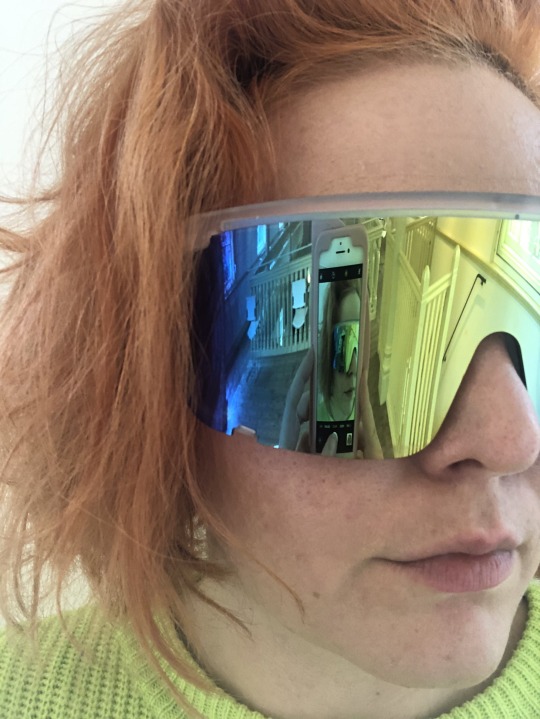
Reflective reflections. Some props I acquired.
vimeo
....becoming something with others.
Barad, K. M. (2007) Meeting the universe halfway: quantum physics and the entanglement of matter and meaning. Durham: Duke University Press. Brown, B. (2012) Listening to shame. (TED2012). Available at: https://www.ted.com/talks/brene_brown_listening_to_shame (Accessed: 15 November 2020). Felden Krisis (@somatic_based_content_only) • Instagram photos and videos (no date). Available at: https://www.instagram.com/somatic_based_content_only/ (Accessed: 25 April 2021). Halberstam, J. (2011) The queer art of failure. Durham: Duke University Press. Muñoz, J. E. (2006) ‘The Vulnerability Artist: Nao Bustamante And the Sad Beauty of Reparation’, Women & Performance: a journal of feminist theory, 16(2), pp. 191–200. doi: 10.1080/07407700600744386. Nabokov, V. V. and Nabokov, D. (2011) The eye. New York: Vintage International/Vintage Books. Available at: http://search.ebscohost.com/login.aspx?direct=true&scope=site&db=nlebk&db=nlabk&AN=722896 (Accessed: 25 April 2021). Schechner, R. and Brady, S. (2013) Performance studies: an introduction. 3. ed. London: Routledge. Tactical Aesthetics (2019) Ann Liv Young: Everybody has a responsibility to respond (excerpt from ‘Good Sherry’). Available at: https://www.youtube.com/watch?v=KqEJyWxWzzs&ab_channel=MGM (Accessed: 3 March 2021). Video: Interview with Nao Bustamante [videorecording]. (2002). Available at: https://hdl.handle.net/2333.1/5dv41nv8 (Accessed: 25 April 2021).
22 notes
·
View notes
Link
I’m so proud to announce that I am the first-ever openly asexual person in Paper Magazine! It’s a great step for asexual visibility, I can’t believe I’m in a publication like this speaking about the importance of asexual visibility. Your support has made this happen. We are here, we are being seen.
Spread the word!

When we talk about the LGBTQIA+ community, there still isn't a lot of talk about the "A" portion, and that's something UK-based model and activist Yasmin Benoit is actively trying to change.
As an asexual and aromantic person, Benoit does not experience sexual or romantic attraction. And while she's spent the majority of her life comfortable with this knowledge, it's also something she knows isn't the case for many others — and a lot of this can be chalked up to a dearth of asexual and aromantic representation.
So, using the platform and visibility she built as a model, Benoit has spent the past two years making videos, writing posts, and giving talks about the topic, which is still rife with misinformation and harmful stereotypes. According to her, "when you say you don't experience romance and sexuality and that those things are, innately, not a part of you, people think you're less human," which she says is a result of the importance society places sexuality.
"[They say] you're robotic. You're psychopathic. I often get narcissistic," as Benoit explains, before launching into the misconceptions she has to deal with on a daily basis. The biggest one? Her occupation, especially when it comes to her work with lingerie, almost always elicits a confused public reaction. Even though the rationale behind modeling lingerie is simple: she likes the garments and enjoys mixing up her portfolio.
"People find it weird as an overlap, because I'm asexual," she explains. "People think if you're modeling lingerie, something sexual is going on. They don't realize I'm just standing there for a couple hours, making a little conversation and shaking hands, before I go home."
Yet despite Benoit's sound logic, she says she still, on the daily, runs into a lot of questions surrounding her job, which is "seen as an oxymoron" — likely due to the inherent sexualization of lingerie modeling. That said, she says this isn't the most troubling assumption she's had to deal with, as exemplified by the myriad of invasive questions pertaining to why she's asexual and aromantic.
"Literally, yesterday, I had a man insisting I had been molested, and I was just hiding it and repressing it," she uses as an example. "He was insistent that that was obviously my issue. They think sexual attraction is the most human thing ever, and it's impossible to not feel that. You can't be human if you don't feel anything."
Sadly though, this sort of presumptuous projection and unfounded theorization has been happening to her from before she even figured out that there was terminology for how she felt. As Benoit says, she'd constantly be "quizzed on my sexuality" from the time she was around 9.
"Once other people around me started getting more hormonal, more into dating and going out with each other, I was like, 'This is kind of silly. I just want to stick by myself and play with my Legos,'" she recalls. "I assumed it would kick in for me, but it wasn't something I encouraged."
Unfortunately, Benoit says that once people began noticing that she "wasn't reacting to things the same way" as other girls her age — talking about her crushes or fantasizing about boys — they began coming up with theories, with some people even going so far as to tell her about their hypotheses, which ranged from theories about her being gay, a religious prude, a potential survivor of sexual abuse, or "just mentally slow."
"Because I wasn't reacting like everyone else, they concluded that I was stupid," Benoit explains, also mentioning that she's had to put up with other people assuming that she was repressing sexual trauma or that she was hiding a secret perversion. "But I just didn't understand why other people were trying to work it out for me, because there wasn't really anything to work out. I hadn't been molested. I don't have sexual hang-ups. I'm not against sex. There was nothing to work out."
That said, even once she learned about asexuality and aromanticism, that apparently "didn't stop people from coming up with theories" — including her own father, who she says recently went so far as to accuse her of pedophilia. But all the naysay has also, in part, spurred Benoit to dive into the world of activism.
As Benoit started gaining traction as a model, she began toying with the idea of mentioning her asexuality online in an effort to reach others grappling with their asexuality. This all resulted in a casual post about the topic, as well as the release of a video called "Things Asexual Girls Don't Want to Hear" — something she genuinely "didn't think people would care that much about," but ended up "spiraling, because not a lot of people talk about it."
"The asexual community was very happy to see someone with a platform discussing it," Benoit explains, later adding that she had "people messaging me how much it meant to them, which [made me feel like], if doing something so simple is really impacting people's lives, I might as well keep doing it." Benoit adds that she'd love to see more asexual and aromantic role models out there, especially since the stigma is so prevalent. After all, as Benoit explains, a lack of visibility and understanding surrounding asexuality and aromanticism makes those grappling with their identities much more hesitant to "come out" — whether we're talking about men, for whom sexual desire is "seen as such a quintessential trait of masculinity," or an asexual person who doesn't want to potentially "embarass" their romantic partner.
For now though, Benoit is doing what she can, with her most prominent push toward asexual visibility so far being a hashtag she started last year called #ThisIsWhatAsexualLooksLike, which aims to "dispel the idea that theres an asexual way to look or dress."
"People often say I don't look asexual, and I don't dress asexual, but what do you think that looks like then?" she explains. "I was trying to show the diversity of the community and, at the same time, give a tool back to others, so that they can represent themselves without relying on the media."
"There is a lot of stigma still around, so asexual people can go decades without realizing there's a word for what they're not feeling."
That said, Benoit's also quick to posit that while her asexuality and aromanticism have "never been a secret," it took her until that point to "realize I was filling a space and providing that visibility, especially for asexual minorities." That said, she also mentions that being a Black asexual activist is also an especially tenunous task, as there's a huge racial disparity when it comes to visibility.
"People perceive my asexuality differently than white asexual people," Benoit says, before mentioning the televised version of a documentary that she was cut out of — something she believes is "reflective of people higher up in the company who looked at us and was like, 'She doesn't make sense.'"
However, in the uncut version posted online, Benoit said the comments about her were much more "sexually aggressive and racialized" than what the other white activists got. "There was a lot more anger directed at me," she says. "People find it harder to compute that a Black woman can be asexual just because we're hypersexualized a lot more."
And though she acknowledges the difficulties of being a Black activist, Benoit says she's undeterred in her mission to continue spreading visibility and tackling the misconceptions and stigma surrounding asexuality and aromanticism. Her next steps? According to Benoit, she's currently working on a BBC radio series about asexuality, starring in another documentary about the topic, and potentially doing more talks at sex-positivity conferences and international Pride events. However, she's also eager to help organize more events in the UK that would provide physical spaces for asexual and aromantic people to convene and feel seen as well as supported by others.
"There is a lot of stigma [and misconception] still around, so even asexual people can go decades without realizing there's a word for what they're not feeling," Benoit says. "That has to change."
Article written by Sandra Song.
Hair & MUA: Fey Adediji (@beautybyfey_) Photography: Matt Parker (@mtyparks) Lingerie: Playful Promises Model: Yasmin Benoit (@theyasminbenoit)
#this is what asexual looks like#yasmin benoit#asexuality#asexual#asexual awareness#asexual pride#aromantic#matty parks#paper magazine#playful promises#lingerie#lingerie model
862 notes
·
View notes
Text
INTERVIEW WITH SOEJIMA - pixivision
SOURCE: https://www.pixivision.net/en/a/2403
Creative Process
What software are you using mainly?
Paint Tool SAI and Photoshop.
For the part where I use my pen tablet, I use SAI. So lines, coloring… I use Photoshop mainly to adjust the colors and to add special effects. Sometimes I also use CLIP STUDIO.
Do you use a LCD tablet or a regular one?
I’ve been using a regular tablet for the longest time, ’cause I didn’t like the idea of hiding my illustrations with my hand. However, I heard so many times about how great LCD tablets are that I’m thinking to get one. (laughs) I’m a creature of habit. If there’s a device I like to use, I’ll keep using even after it gets obsolete. Other members of the staff, though, use much newer things.
If you're a creator, you have two choices: to work as a freelancer and to work for a company. Can you tell us the advantages and disadvantages of being an employee?
When you're a creator of any kind, it can be hard to complete a project or gather all necessary ideas by yourself. Having a group of people around you can really help!
Also, you can get all the equipment you need. If you tell someone "I need this thing for my work", they're gonna buy it for you. And I'm not only talking about hardware - they'll gather resources and whatever else you need. One of the merits of working in a company is that the environment built around you is thought for work.
However, the thing I like the most is the dynamism that working for a game company creates. Many brains mean many ideas, many illustrations, many people involved in the game. I really love this about Atlus.
The disadvantage is... Having a last train home. (laughs) There are limitations on how much we can work, so if I end up staying too late someone is gonna get angry at me.
But let's think about it. You need to learn self-management this way, and that's not necessarily a bad thing.
Can you tell what goes inside the head of a character designer? How can you become good at it?
"Character design" means to create the setting for a certain character, but I think that the ability to draw is a prerequisite in order to be able to convey all their characteristics.
A thing I realized when I entered this company is that even if you're good at drawing, that doesn't mean you will make a good character designer. Competitions inside the company can get pretty harsh, but sometimes it can happen that designs from people who can't draw end up being adopted. For the initial concept, stick figures are usually better than super detailed characters.
It might be hard to get good at design if you're not that good at drawing, but I'm pretty sure that "drawing skills" and "design skills" are two completely different things. I realized all these things after joining Atlus, and since then I've always been drawing to increase my skills as a designer.
What is the best way to increase your skills as a designer?
Of course, it's important to observe what's around you... But there's something less vague that you could do.
Personally, I started from asking myself: "What's the thing that I enjoy the most?"
I think when you start drawing something you're always influenced by what's popular at that time. Then, you start looking for ways to be different from the popular creators. However, you don't always get results right away. I was even scolded by my boss because I couldn't find a satisfying output, a way to be different. (laughs) He told me to just be myself and to draw what I felt like drawing.
Since that moment I started actively thinking about how to create something that was different from whatever came in the past. I started to find the things I was missing.
It's important to continuously try to perfect yourself, both by studying and by finding new interests.
What's the most fun thing about character design?
To give shape to a character that has only a vague image gives me a blast every time.
Characters are not something that I make on my own, but that our team creates together. I like sharing what I made with the team, and everyone usually reacts with "Oh, so this is what this character was like!"
When I have to design a character, I start with written indications. Going from that to an actual physical image... That's the most fun that I have during my job.
And what's the most frustrating thing?
Since design is quite different from plain art, there are many things that I have to consider when creating a character. I have to think that that same character will be made into a 3D model and animated... And if, for example, character A and character B are brothers they should resemble each other.
I have to base my drawings on character settings, and that leads to some limitations. It's very hard to respect those limitations while creating a good character.
What would you recommend to all those who're aiming for a career as an illustrator or character designer?
I think the best method to learn something is "to make it into a job". If you only do something as a hobby, you'll tend to be biased towards things you like.
By entering a company, you'll have the chance to draw both things from your specialty field and things outside of it.
When I joined Atlus I was quite confident about my skills, but I can't say the same about drawing something outside my field of interest. I remember clearly what one of my senpai said to me back then: "Soejima, you pretend like you can draw anything, but you actually can't draw at all". (laughs)
So instead of working at your desk and thinking "I'd like to make this into a job one day", get out there and make it into a job.
2 notes
·
View notes
Link
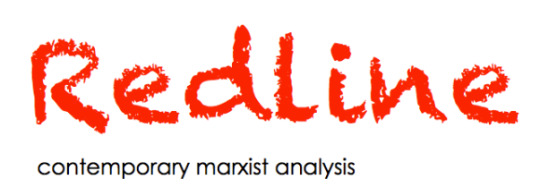
New Zealand schools have introduced a climate change resource that suggests children “eat less meat and dairy”, even though teachers will not know how much meat or dairy any child in their care has eaten. Opinion pieces in the papers have called for the reduction of meat and dairy in hospital menus, not usually generous sources of such foods, despite the well-known risks of undernutrition, especially of protein, in the frail and elderly. Globally, the influential and once-objective medical journal the Lancet has hosted Eat Lancet, a coalition of vegan and vegetarian technocrats backed by processed food manufacturers, and promoted their agenda. The Guardian newspaper accepted an £626783 grant from the backers of Impossible Foods to run a series of articles against animal agriculture.
These initiatives, aimed at remodelling our food supply in a way that favours the multinational food processing and seed-and-chemical corporations, whose control of many aspects of farming and diet is already problematic, have run far ahead of the scientific community’s efforts to understand the health effects of such dietary change.
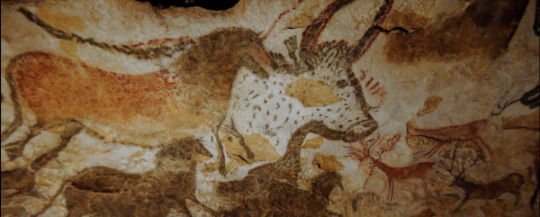
Our hunter-gatherer past
The Neolithic Revolution was the first alteration in human affairs that is generally considered worthy of the term Revolution. In Marx’s terms, it saw a change in the means of production sufficient to form new classes aware of their identities, and thus a change in the relations between people. Early humans had fed themselves in an opportunistic, hunter-gatherer fashion that tended to favour a diet of animals supplemented with plants where and when these were available. Large animals made the best meals but gathering activities could collect many smaller ones, as well as eggs, grubs etc.
The people of the Mesolithic era discovered that some animals could be herded and some plants grown in gardens (not usually by the same community, because one activity favours nomadism and the other favours a sedentary habit) but these activities, which greatly improved food security after the decline of the prehistoric mega-fauna due to hunting and climate pressures, tended to occur at the communal level and probably did not create major class differences between the people involved.

The invention of farming
The Neolithic Revolution, which unleashed the human potential for war, creativity, and social division, resulted from the identification of the germs of plants (specifically grains and legumes) as durable sources of energy. If grains were grown (I will use grains in the wider sense of “cereals”, after Braudel, including other dried germs such as peas) and there was a surplus, this surplus would still be edible over the next year, a year when drought or pests or diseases might wipe out the other food sources that hunter-gatherers depended on. This advantage was offset by the nutritional poverty of grain-based diets, so that tuberculosis probably became an endemic disease during this period,[1] but the existence of a less-perishable surplus allowed the diversion of part of the population away from food gathering for large parts of the year, and saw the creation of armies and other workforces.
In Europe, the Neolithic Revolution is dated at around 10,000 BC and its arrangements are a matter of prehistory, but in China this change occurred later and the written record around Bi-gu or grain avoidance includes folk-memories of conflict between grain eating and grain avoiding peoples.
The history of colonisation is the history of the conquest of lactose-intolerant peoples by lactose-tolerant populations, and of non-grain eaters by grain-eaters. In the Indian sub-continent, a combination of dairy herding and a cereal diet high in legumes uniquely allowed the survival of a substantially vegetarian population, and saw the conservation of genes favouring reproduction on such a diet, including genetic polymorphisms still rare in European populations (adaptive mutations only predominate where many individuals without them have failed to survive or reproduce).[2] That the Indian social system became more aggressively class-based than any other is probably no co-incidence; prejudice against meat-eating is still used as a tool of social control against minorities, while meat-eating is one way young Indians today identify as modern and egalitarian. However there were some important exceptions to the trend – the Aztecs were a hunter-gather people who conquered and dominated the Mesolithic agriculturalists of Mexico, and the Mongols were nomadic herders and hunters whose greater stamina and independence allowed them to defeat the rice-fed armies of the Chinese Emperors (after conquering this breadbasket, the successive Mongol Khans seem to have eaten and drunk themselves to death).
Early vegetarian ideology
In the European and Asian cereal-based societies the poorest classes went without meat, supplementing cereals when possible with buttermilk or blood pudding which were more economic replacements. The rich ate as much meat as they could. The idea that an entire society might avoid meat is a recent one with its roots in religious practice, and, insofar as it has any political basis, this flows in two distinct streams – the eco-fascist, in which meat avoidance is a sign of “purity”, most humans are a burden on the Earth, and the Indian vegetarians are of course Aryans. This is something like the vegetarian vision that Adolf Hitler picked up while studying anti-Semitism with Wagner’s heirs at Bayreuth.
And then there is a Marxist-Anarchist, and latterly Intersectional, version, founded on a valuation of animal rights as inseparable from, and a logical extension of, human rights. Vegetarianism was a frequent obsession of the early British Socialists; G.B. Shaw, who derived most of his energy from dairy fat and lived to the age of 94, made himself into a well-known example, and the idea was sufficiently entrenched among the British Socialists and their milieu that H.G. Wells preserved its internal contradictions for posterity in The Time Machine. In his far-future vision, humanity has evolved into two separate species. The Morlocks are descendants of working-class meat-eaters, the Eloi of leisure-class vegetarians – all Wells’ loathing is reserved for the Morlocks, yet it is obvious they are (still) the engineering brains keeping their world running and the Eloi fed. The Eloi are useless for anything but enjoying the sunshine and feeding the Morlocks, and the discordance in Wells’ progressive values as he describes both species is as shocking as anything else in the story.
The first large-scale experiment in plant-based protein was attempted by the Bolsheviks. As usual, it’s hard to separate the roles played by idealism and cynicism in the story, but the bare bones are that the Soviets found their initial attempts to remodel the countryside rebuffed, blamed this on the recaltricance of the kulak class, and set out to destroy them. The problem being that the kulaks, owning most of the cattle and sheep across the Russian Republics, helped to feed the people. Beginning in the 1920s, soy experts from the USA (then the Western world’s leading soy producer) were among the many foreign technicians imported into Russia, and soy processing plants were built and soy production increased to 283,000 tonnes in 1931, the year Stalin unleashed enforced collectivisation and the terror against the kulaks (and also the Kazakhs, a herding people who suffered the largest proportionate loss of life during this period). This led to the loss of millions of animals, either killed by their dispossessed owners or mismanaged by their inexperienced new owners. The soy project was hardly able to prevent the massive famines that followed, and by 1935 soy production had dropped to 54,000 tonnes. Though soy milk would later prove useful during the siege of Leningrad, by the 1930s soy had probably only served one purpose, as a statistic needed aforehand to quell the objections of pragmatic delegates to the destruction of the kulaks and their livestock.
Today we face the revival of this idea, of plant protein that will create a world with no need for animal protein, and the remodelling of life in the countryside, with the new impetus of climate change as its driver. Livestock cycles natural carbon, meaning there is no net addition of C02 to the atmosphere – and its contribution to the shorter-lived methane precursor has not changed since 2000 (methane rises have been due to fracking, methane itself AKA “natural gas”, landfill, and rice production; methane-emitting animals have always existed on Earth in substantial numbers, and have not created a novel situation in the sense that the discovery of coal, oil and gas did). We have recently seen how much global disruption is required to reduce fossil fuel CO2 emissions to 2006 levels, levels which will still warm the planet if they continue. It could be still be worth reducing agricultural cycling of CO2 through methane, which is more warming than CO2 if this is cost-free, but is it?
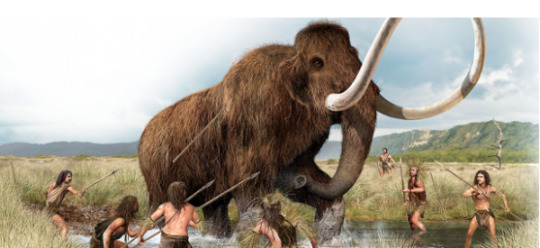
Why humans evolved as meat eaters
Animal foods, and especially red meat, supply a constellation of nutrients not found together (if they are found at all) in any plant food. Nutrients are those chemicals essential for the functioning of the human organism, and plants, but not livestock, can survive well without nutrients such as amino acids, fatty acids, vitamins and minerals that are essential to humans. Surviving as a vegetarian or vegan is possible for some (perhaps assuming the genetic variants referred to earlier are present) but to thrive requires knowledge of these nutrients, where to find them, how to process the foods that supply them, or how to supplement them. Thriving as an omnivore or even a complete carnivore does not – nutritional sufficiency is the reason we evolved eating meat and other animal foods long before we learned there were such things as essential nutrients.
The reasons for avoiding meat or all animal foods can have a class basis – veganism may be taken up by educated middle-class adults, more likely to be exposed to “health food” ideas and aware of the need to supplement, some of whom then commercialise their habits as social media “influencers”. Meat avoidance is also being adopted increasingly by educated middle-class children for identity or compassionate reasons, but the poor may also avoid meat because of its cost when a loaf of bread or a packet of flavoured noodles can be bought for a dollar; these two motivations sometimes coincide when students in temporary poverty make a virtue of what they perceive to be a necessity.
Does the meat-avoiding behaviour of young people have unintended costs? Several observational studies have looked at the characteristics of meat-avoiding populations and found alarming increases in depression, anxiety and self-harm.
“The majority of studies, and especially the higher quality studies, showed that those who avoided meat consumption had significantly higher rates or risk of depression, anxiety, and/or self-harm behaviors. There was mixed evidence for temporal relations, but study designs and a lack of rigor precluded inferences of causal relations. Our study does not support meat avoidance as a strategy to benefit psychological health.”[3]
How can we explain these correlations? Why should we assume that they are causal?There are several lines of evidence to support a causal link: 1) several nutrients found in meat and animal foods are important factors in mood and cognition; vitamin B12, iron, carnitine, DHA, choline and tryptophan are some examples.[4] 2) the fatty acid mix in dairy and red meat has a similar composition to that of amniotic fluid and breast milk which has anxiolytic (anti-anxiety) effects in young animals.[5] 3) soy is a convenient and cheap replacement for animal protein; soy processing in Western diets results in a 10-fold higher level of the estrogenic contaminant isoflavone than that found in Asian diets.[6] Soy isoflavone causes anxiety behaviour in young female animals, and there is evidence supporting psychotropic and hormonal effects in humans.[7,8,9.10] Interestingly, while right-wing critiques of soy eating focus on effects it can have on young men, the scientific evidence for adverse effects in younger females, converting to HRT-like benefits after menopause, is stronger.[11] 4) other toxins found in plants, such as salicylates and oxalates, as well as problematic proteins such as gliadin/gluten and zein, may be present at higher levels in meat-free diets (but are not unique to them). A vegan mince sold in Countdown supermarkets is simply a coloured blend of soy protein and gluten, a protein linked to the risk of schizophrenia.[12] In the New Zealand context it would be relatively easy to confirm or dispute some of these associations. Everyone admitted to hospital for longer than a day supplies their dietary preferences. The dietetic preference data from psychiatric admissions could be both linked to outcomes over time and compared with the population average distribution, or the distribution in a ward where diet is least likely to play a role in admissions.
Iron deficiency in women
Young women in New Zealand are the most likely to report being vegan or vegetarian in surveys, as elsewhere in the world. Vegans in the Gender Studies field generate papers linking meat to masculinity, with the implication that this masculinity is toxic and might be improved by a plant-based diet.[13] The corollary of this belief – that women may therefore be weakened by meat-avoidance – is never considered. In a 1980 essay by Gloria Steinem called The Politics of Food (in the collection Outrageous Acts and Everyday Rebellions) she describes some of the cultural constructs by which women are deprived of the good nutrition which men use to stay dominant. The belief that men need to eat red meat more often than women may have been valid when the average man was more likely to have to survive an attack by a wild bear than the average woman, but today it is mainly women who suffer from serious iron deficiency. The rate – and the cost to the health system – is increasing in New Zealand as more women give up meat. Iron deficiency anaemia in early pregnancy is associated with neurodevelopmental disorders in children, not an outcome that will increase the mother’s autonomy.[14]
In Georg Büchner’s 19th century “working class tragedy” Woyzeck, filmed by Werner Herzog with Klaus Kinski in the leading role and the subject of an opera by Alban Berg, the title character, a soldier, is subject to experimentation by a sadistic army doctor. The experiment involves Woyzeck living on nothing but peas. Peas may supply a complete protein, but Woyzeck goes insane; the deprivation being the final straw in his alienation. James Cameron, the film-maker responsible for Avatar and Titanic, is investing heavily in pea protein as if this were his gift to New Zealand. I am not sure whether he has watched Woyzeck – one would think he has.
Plant-based vs meat-based
Again, we have the specificity of plant germs as commodity; their low cost of production, long storage life and versatility of processing outcomes makes them an ideal investment and a robust one, as poverty and adversity increases their consumption, as we saw during the 2020 Lockdown Event. However, a plant-based burger is nutritionally greatly inferior to a meat burger, and that burger is often the most nutritious single food item many will people eat in the course of their day. The current push to eat a plant-based diet for “planetary health” is something that all the multinational food processors have signed up and provided funding for, and why not – Coca Cola, Unilever, Nestlé have always sold us plant-based foods. We notice that while iron-deficiency anaemia increases in New Zealand with the reason in plain sight, Nestlé scientists here in NZ are developing a more potent form of supplemental iron to add value to their products as their parent company backs the push to reduce meat. (As usual, it’s hard to separate the roles played by idealism and cynicism in the story). But, you may well ask, isn’t eating meat linked to an increased risk of cancer and heart disease? These associations are small to begin with, but they are also intensely confounded by social class and educational status. Supposing a factory that makes a carcinogenic chemical is hiring. Who is more likely to apply for that job – a meat eater (who will likely have a bigger family to support, among other considerations) or a vegan? Who, so to speak, eats all the pies, and needs food that is filling and nutritious without having to give it much thought? Who is more likely to work two jobs and be exposed to the disruptive metabolic effect of shift work? Carcinogen exposure and shift work are just two of the confounding variables ignored in diet epidemiology. (That meat-eating in Western populations may symbolise or associate with labour itself – as it did for H.G. Wells when he wrote The Time Machine – is not a consideration I have found discussed in the epidemiological literature.)
Certainly one can think of mechanisms that might link meat to disease, as one can with any food, but one can also think of protective mechanisms; several of the nutrients found mainly or only in animal foods are required for various antioxidant and immune defensive enzymes, and some like carnitine and EPA even have a place in the management of heart disease. The argument against meat-eating should not be confused with the argument for sometimes rationing a valuable food that is in short supply. The wartime rationing of meat in the UK is thought to have improved the health of the poorest by guaranteeing a greater supply than they had had previously, at a more affordable price. In Europe, the peasants who supplied the cities with meat, dairy and luxury foods such as oysters were sometimes forced by network disruptions to consume these foods – which many of them had never tasted before – with benefit to their own health.
The plant-based agenda can scarcely be expected to recognise these benefits, or understand the argument summarised by Williams and Dunbar (with regard to the vitamin nicotinamide and amino acid tryptophan in their tuberculosis paper), that if better data collection and analysis resulted in us ”…returning to our egalitarian past and redistributing meat or its components that supply NAD (avoiding both the highs and the lows between individuals and over individual lifetimes) [this] may be more effective than subsidizing corn grain (while the increased prosperity from unlocking human potential should pay for the intervention).”[1] Progress – which includes unlocking human potential from the chains of preventable mental and physical disease – depends on good data, and we do not yet seem to collate the data required to know whether or for whom plant-based diets are safe in New Zealand.
George Henderson works as a researcher for Professor Grant Schofield and the team behind the What The Fat books and the social enterprise PreKure, which has been running free lifestyle and health programs through the lockdown. He is the author or co-author of several scientific articles and letters published by the BMJ, Lancet Diabetes and Endocrinology, the JAMA, and other journals, including an influential review of low carbohydrate diets in diabetes management for the New Zealand Medical Journal. A musician, songwriter and amateur musicologist, he has recently presented a series of podcasts on 20th century women composers for Karyn Hay’s Lately show on RNZ.
References:
[1] Williams AC, Dunbar RI. Big brains, meat, tuberculosis, and the nicotinamide switches: co-evolutionary relationships with modern repercussions?. Int J Tryptophan Res. 2013;6:73‐88. Published 2013 Oct 15. doi:10.4137/IJTR.S12838 [2] Kothapalli KS, Ye K, Gadgil MS, et al. Positive Selection on a Regulatory Insertion-Deletion Polymorphism in FADS2 Influences Apparent Endogenous Synthesis of Arachidonic Acid. Mol Biol Evol. 2016;33(7):1726‐1739. doi:10.1093/molbev/msw049
[3] Urska Dobersek, Gabrielle Wy, Joshua Adkins, Sydney Altmeyer, Kaitlin Krout, Carl J. Lavie & Edward Archer (2020) Meat and mental health: a systematic review of meat abstention and depression, anxiety, and related phenomena, Critical Reviews in Food Science and Nutrition, DOI: 10.1080/10408398.2020.1741505 [4] Frédéric Leroy & Nathan Cofnas (2019) Should dietary guidelines recommend low red meat intake?, Critical Reviews in Food Science and Nutrition, DOI: 10.1080/10408398.2019.1657063 [5] Contreras CM, Rodríguez-Landa JF, García-Ríos RI, Cueto-Escobedo J, Guillen-Ruiz G, Bernal-Morales B. Myristic acid produces anxiolytic-like effects in Wistar rats in the elevated plus maze. Biomed Res Int. 2014;2014:492141. doi:10.1155/2014/492141 [6] Fernandez-Lopez A, Lamothe V, Delample M, Denayrolles M, Bennetau-Pelissero C. Removing isoflavones from modern soyfood: Why and how?. Food Chem. 2016;210:286‐294. doi:10.1016/j.foodchem.2016.04.126 [7] Hicks KD, Sullivan AW, Cao J, Sluzas E, Rebuli M, Patisaul HB. Interaction of bisphenol A (BPA) and soy phytoestrogens on sexually dimorphic sociosexual behaviors in male and female rats. Horm Behav. 2016;84:121‐126. doi:10.1016/j.yhbeh.2016.06.010 [8] Tillett T. Full of beans? Early soy exposure associated with less feminine play in girls [published correction appears in Environ Health Perspect. 2012 Jan;120(1):A17]. Environ Health Perspect. 2011;119(12):A525. doi:10.1289/ehp.119-a525b [9] Adgent MA, Daniels JL, Rogan WJ, et al. Early-life soy exposure and age at menarche. Paediatr Perinat Epidemiol. 2012;26(2):163‐175. doi:10.1111/j.1365-3016.2011.01244.x [10] Hibbeln, J.R., SanGiovanni, J.P., Golding, J., Emmett, P.M., Northstone, K., Davis, J.M., Schuckit, M. and Heron, J. (2017), Meat Consumption During Pregnancy and Substance Misuse Among Adolescent Offspring: Stratification of TCN2 Genetic Variants. Alcohol Clin Exp Res, 41: 1928-1937. doi:10.1111/acer.13494 [11] Patisaul HB, Jefferson W. The pros and cons of phytoestrogens. Front Neuroendocrinol. 2010;31(4):400‐419. doi:10.1016/j.yfrne.2010.03.003 [12] Čiháková D, Eaton WW, Talor MV, et al. Gliadin-related antibodies in schizophrenia. Schizophr Res. 2018;195:585‐586. doi:10.1016/j.schres.2017.08.051 [13] Jessica Greenebaum & Brandon Dexter (2018) Vegan men and hybrid masculinity, Journal of Gender Studies, 27:6, 637-648, DOI: 10.1080/09589236.2017.1287064 [14] Wiegersma AM, Dalman C, Lee BK, Karlsson H, Gardner RM. Association of Prenatal Maternal Anemia With Neurodevelopmental Disorders. JAMA Psychiatry. 2019;76(12):1294–1304. doi:10.1001/jamapsychiatry.2019.2309
3 notes
·
View notes
Text
Is the Alok Badatia course really helpful?
Are you someone who is facing difficulty in deciding the best digital marketing course in India
Or the course which helps you to become the top digital marketer of your industry and skyrocket your career?
Or,
Are you someone you have done lots of digital marketing courses, even fail to crack job interviews?
If you want to know why you fail, Please read this article
The same happened to me also I was also confused as to which institute to choose because the core of these problems is the increasing fraudulent in the market so-called “best digital marketing course in India’’ That lot of people have been fallen for and wasted a lot of money and time.
The big problem is these ‘’Fake Gurus’’ with their fake course it just becomes means of robbing money for them. They just take without caring about how the third person is arranging money.

I had searched and spoken to several institutes as well attend free class But I am not satisfied due to lack of mentorship and improper knowledge and most of the people buy these type course and waste their money.
However, One day I attend the free class trial of Mr. Alok Badatia, and it really satisfied and touched my heart in this one-day free class trial I found all the things that I was missing in my earlier course.
His sincerity, his teaching style, and the way he encourages the student to work hard, and he is not only Asia’s best trainer but also the life-changer of many students.
Alok Badatia is the founder of AADME and Digital 365.
“AADME” is Asia’s best platform to learn advanced agency level of digital marketing program and Digital365 is the company that provides full digital marketing services, both are run by Mr. Alok badatia Sir.
But, Now the question big question is:-
Is Alok Badatia Course is really helpful?
Well in my opinion it is the best digital marketing course in India, but you can not only learn digital marketing but also get the mindset of learning things.
It is the course where you not only learn thing how it works but also implement it practically.
He trained more than 50000 students, and they have gained the idea of how to provide the thing to the student that becomes easy for the student to learn and implement.
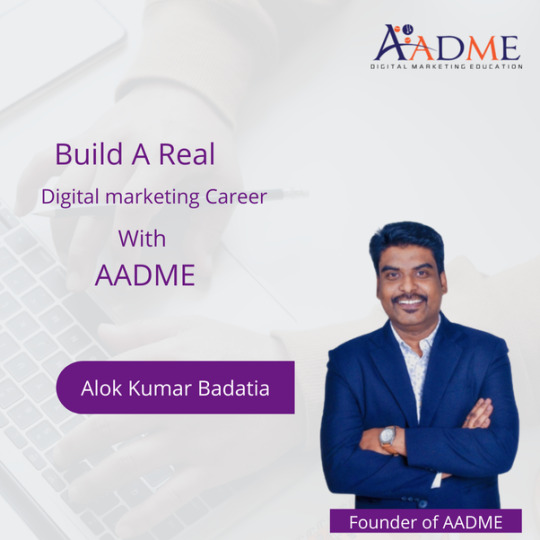
You will be huge benefits from the AADME . One of the most valuable benefits is lifetime mentorship by Alok badatia sir.
There are some more reasons for choosing Alok Badatia Or AADME Course are-:
1. Unlimited Doubt Session
In Alok badatia’s Institute, this is the biggest facility provide by the AADME team that you will clear your all doubts from Alok sir if you have startup ideas, and you are facing some problem then, You will also get full support from Alok Badatia Sir.
2. Live Face to Face Session
There is much digital marketing course out there that are going to provide you with just recorded lessons or recorded classes but leaning digital marketing should take place in a perfect handholding and mentoring and AADME provide you the live classes where you can interact with your mentor.
3. Personalized Training
It is the first institute that provides personalized training and real-time handholding support and helps you wherever you're stuck.
4. Internship Included in the training
It is one of the most important factors while pursuing a training program, Unless and until you implement what you’ve learned under the supervision and guidance of an experienced professional.
You won’t understand what is actually required in the digital marketing industry and most of the institutes not providing internships it is the reason's why most of the students even after spending thousands and still do not get the job.
5. Assignment Based training with regular Feedback
Self-learning is very important in your life if you want to grow in your life.
They give you the assignment, and you have to complete and submit it and if you have doubts then, you can directly contact the mentoring team, and you're all the doubts get resolved within 24 hours.
6. Get work experience
No company wants to hire fresher these days. Everyone wants someone with legit work experience, and you will also get the working experience by working on client projects with makes it easier for you to get a job.
7. Niche-oriented personalized training
This type of training only happens when you are really taking the training from the most experienced person, and it also depends on the batch size, they have a limit of only 40 students in a single batch.
And it's not a big batch size they, so everyone can engage with mentor and niches is really time taking task because every niche is different, has different buyer’s persona, has different digital marketing strategies with this Alok Badatia sir will guide you properly.
8.Support for your Startup
Everyone reading this blog must have some business idea that he wants to grow in near future, and they feel that can grow and generate sales using digital marketing, then you will get one special session for that.

9. Learning Management System
They provide India’s biggest LMS where you will get all the live sessions and recorded material
Because digital marketing is completely tool-based training where you need to learn a lot from the tool and most of the institutions provide recorded, and it is also not updated and not lifetime access.
‘’AADME’’ will give the lifetime access and LMS is always updated with the duration of 3 months because digital marketing is an ever-evolving field, the course material is always needed to update.
So that if in future you are applying for any job or running any campaign for anyone, you can refer to the LMS and these benefits make the best digital marketing course in India.
10. Trainer’s Industry Experience
This is also one of the most important things that need to consider while choosing, and Alok sir has more than 15 years of experience and trained more than 50000+ and change in their life.
Because his main aim is to build leaders around the world, and he started his journey as a blogger turns into a freelancer and agency owner So, they know what are the thing working in the industry what is not.
Conclusion
If you want to also learn from the Global Digital Marketing Coach with Asia’s best platform of advanced level agency-based digital marketing training programs.
So if you don’t want to waste your money here and there by purchasing a cheap and irrelevant course then, without wasting any time, enroll right now. Because Alok sir is the mentor which gives you the exact roadmap to grow in your carrier and makes you the leader, and his mentorship is life-changing.
Remember-: An investment in knowledge pays the best interest.
1 note
·
View note
Text
Biomech Lore Post
Because I may as well go about it already! (Though do note that these are referred to as “Weapons” in FFXIV-related universes; a coincidence of a project name, having little to nothing to do with the VIIth Legion’s Weapon program, given that it’s run by the IXth Legion instead.)
More under the cut!
I generally consider these guys to be fandomless, with various details tweaked to fit whatever universe or RP thread or etc they’re being used in. Of which there are a few...but one thing that’s consistent through all of that is that these guys are all, to varying degrees, part biological and part mechanical war-weapons, though their external appearances imply the latter over the former. They’re also all quite self-aware and sapient, even if for some of them, the way their telepathic “voice” speaks implies a more alien intelligence that has to actively bend itself to be understood by human pilots at all.
This telepathy is key to controlling a biomech; physical controls do exist, but a pilot (or pilots, plural, depending on the universe) must have a strong and consistent mental link with the biomech in question in order to truly utilize it beyond simple, slow movements such as those needed to move a biomech into storage. As for who exactly has this mental link of a quality high enough to pilot, this again depends on the universe: in some, the biomechs are built/grown “to order” for a specific pilot, and in others, the pilot (or pilots) have to be found in the ranks of the existing military. In the latter situation, it’s deemed far less than ideal to have this problem—there’s no guarantee that the military even has an appropriate pilot that can connect to it—but the benefits are considered to vastly outweigh the risks. Or, sometimes, the wider world situation (IE: ongoing apocalypses and/or specific enemies normal military hardware can’t touch) dictates that they have no other options.
This link, however, does not come without some risks. It’s particularly intense on single pilots, and in some universes actually causes a great deal of brain damage or mental deterioration from the neural overload if not spread out over multiple minds (whether this takes the form of a Drift-style multi-pilot setup or something more akin to a pilot hive mind). This has led to more than one rumor amongst rank and file personnel that biomechs steal their pilots’ souls...which in a couple cases in particular may not be unsubstantiated.
As for what a biomech is grown out of, that is kept a tightly-guarded secret. But it’s always (with only the FFXIV ‘verse being exempt) some variety of elder dragon or dragon-monster, hence their draconian appearances. (For the FFXIV ‘verse: they’re either grown out of or cloned from a concept-creature of the Ancients’ world, which took the form of a giant squid-like being.) They‘re essentially lab-grown into their mechanical shells and systems, and once fully integrated with them, then awoken. This process varies, again depending on ‘verse, and can be as simple as a Frankenstein-esque shock of immense power, or as complex as ritual magic. Their brains are not considered to be in their heads but in their “cores”, which are grown and built first to be buried in the biomech’s chest—meaning that, even though a headshot or decapitation would be traumatic for all involved (including the pilot) and remove a significant amount of sensory input, a biomech can indeed continue to “live” without a head and can, even, have one regrown. These cores are also part mechanical and part biological, taking the form of a mechanical shell over a biological inside, but very few have ever actually seen one outside of lab technicians.
Their personalities are considered set in stone, however. Even on the rare occasions that a biomech has been re-grown—as in cases with known pilot refusals—their general temperament and thought processes remain the same, though the regrowth process is supposed to obliterate their actual memories. (Supposed to. It’s known to have mixed results.) Pronouns and monikers used to refer to biomechs are generally the biomech’s call and are projected as a wordless overlay on the weapon’s thoughts (so the people hearing it or staying close to it “just know” what a given biomech wants to be called), save in the cases where the biomech itself genuinely does not care—in which case the pilot picks something.
While the military would like to consider biomechs as just tools, of course, there are in fact entire sheaves of ethics and legal arguments surrounding them, given their self-awareness and their status as ultimately manmade creations. This can sometimes cause fairly intense political struggles in certain ‘verses.
Though individual biomechs vary in their combat abilities, a few are fairly standard: they’re resistant to mental and physical corruption, have some self-repair ability (though severe damage requires human repair), and have some variety of energy-based shielding that can be deployed on command. They also all have a mouth-based cannon, though the strength of said cannon varies between individuals: in some cases (such as Hemlock’s) it’s basically intended as a last-resort self-defense weapon that’s fairly weak in power, and in others (such as Blue’s) it’s actually intended to be the primary offensive weapon. Biomechs are also intended to all have some degree of flight capability.
As for some lore on individual biomechs, in order of ascending age:
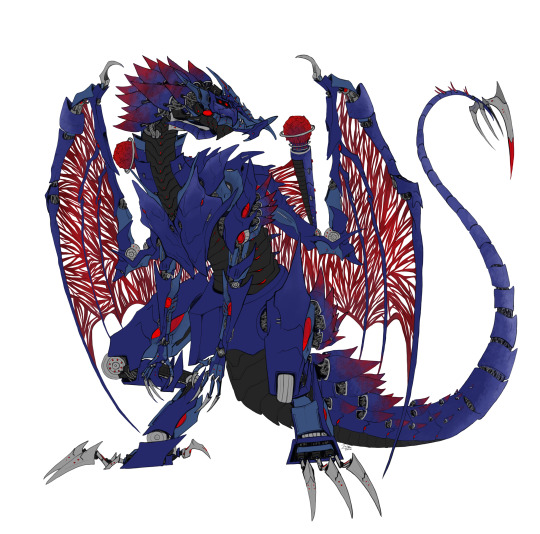
BLUE. The “youngest“ biomech of the lot. Is considered to be a “he”. Personality is best called “chirpy”, and either somewhat dog-like or child-like depending on who’s asked to describe it; he isn’t particularly eager to get into a fight unless he has to. Thought patterns mostly described in terms of feeling like water—splashing, flooding, “like raindrops on their mind”, and so on. Has two main armaments outside of those intended for melee combat:
Mouth cannon. This fires either a laser-like stream of raw energy (or aether in FFXIV), or can also fire a high-pressure stream of water capable of slicing steel. Can be used without any bracing or foot-locks, and pilots are well-advised to learn how to aim it straight mid-flight.
ARIL cannons. These are positioned on the back of the biomech, taking the form of two loosely-attached “spears” on either side of the biomech’s midline, with an unusually biological growth on the fronts of the spears. These cannons are capable of unleashing concussive blasts capable of throwing foes of a biomech’s size considerable distances, but Blue must be standing braced to use them in order to not get thrown in the opposite direction. It is also highly inadvisable to use these on biological constructs; see below section on the ARIL.
The growths in question are collectively called the ARIL, and their substance was also extruded into Blue’s wings and are directly responsible, through unclear mechanisms, for his ability to fly despite his wings’ ragged appearance. What the ARIL is, unfortunately, is also not clear, but it’s considered to be an ancient biological artifact that interacts strangely both with gravity and with biological matter.
Overall, Blue is considered to be a “jack of all trades”-style fighter, capable of long-range attacks while being well able to function in mid or close-range combat as well. In that same vein, his armor is considered middling in strength; enough to protect him from most things but certainly not enough to block rapidly-repeated or severe strikes. His preferred mode of combat is to stay in flight and strike at a distance until an enemy is weakened, then to finish off the foe at close range.
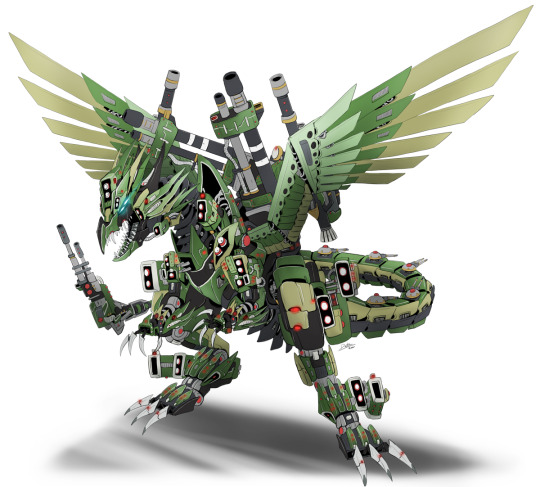
MORRIGAN. The next youngest biomech. Goes by “she”. Very reserved and almost slothful in personality, to the point of serving as a mental “damper” to more violent or energetic minds. Does, however, quite enjoy using her guns and will actively prod pilots to do so, which leads to some only half-jokingly noting that she might be a bit addicted to shooting things. Thought patterns usually described as a slow-moving smoke. Has a great many armaments:
Main cannons. These are positioned on her back, either side of her mid-line. These are exceptionally powerful and capable of punching through all but the thickest armor and the strongest of shields. These do, however, utilize physical shells, and so can and do run out of ammunition. Contains a dozen shots at typical maximum capacity, but this can be expanded by extra equipment. Does require bracing or footlocks to fire with any accuracy.
Mouth cannon. In Morrigan, this takes the form of a powerful, thin, and concentrated energy/aether beam. It is not, however, intended for continuous fire like, for example, Blue’s; it functions in a manner vaguely akin to a sniper’s rifle, its shots short in duration but huge on power. Due to this, however, it’s highly advised to fire from a stable platform of some kind to avoid mis-aiming.
Missile pods. Scattered all over Morrigan’s body. These function as, of course, pods for firing ordinary missiles. Can be fired in sets based on location on the biomech’s frame (head only, arms only, etc), or all fired at once for a devastating barrage. These are locked onto target via either Morrigan’s built-in Radar suite (preferred) or by visual targeting (less preferred, since it requires intense concentration on the target in question by biomech and pilot alike). The number of pods and number of missiles in each pod makes out-of-ammo situations unlikely but possible.
Small tail cannons. Shoot fairly low-intensity defensive energy/aetherial beams, and can swivel approximately 120 degrees to the left and right of biomech midline. Intended solely for deterrence of foes from rear or side attacks.
Tail gun. Composes the entirety of the end of Morrigan’s tail. Can be used for deterrence of rear or side ambushes, but can also be swung around to provide offensive fire at, effectively, any angle. Can shoot either shells or energy/aether shots, depending on pilot selection.
Wing guns. Positioned on Morrigan’s wings, one on each. Fires energy/aether shots of average strength, and can be used in continuous more laser-like fire. These also contain Morrigan’s extra thrusters, required in order to maintain level flight.
Morrigan is intended to be a “turret” of a biomech, planting herself in one spot and firing at long-range on foes. The slowness from her weight and heavy armor makes close combat difficult; in such situations, it’s best advised to get away and back into effective gun or missile range. Flight is mainly intended as a mode of transportation over a means of fighting, but her wings are also intended as a way to stabilize pilot aim.

RED. Goes by “he”. Very nervous and high-strung personality; this is considered to be a fault in a war weapon on multiple levels, including by anyone maintaining the jumpy biomech’s hangar bay, but he’s also considered too large an investment to simply discard (amongst other concerns about the ethics of bluntly destroying a thinking being). Notable for being one of the only biomechs without wings composed of either physical materials or energy/aether, due to a persistent glitch in growth patterns despite multiple attempts to reset it—therefore, is very much of the school of (design) thought of “anything can technically fly if you put enough active thrust behind it”. Thought patterns described as flame-like and flickering. Has only a few weapons:
Mouth cannon. Functions as Red’s main gun, and acts similarly to Blue’s, though with the secondary option of napalm streams instead of a water cannon.
Arm blades. Positioned on Red’s forearms. Has a dual purpose of both providing extra armor and providing an extendable and devastating cutting weapon, whose blades can be superheated to slash through armor layers like butter.
Tail blades. Composes the entirety of Red’s tail. Can also be superheated in the same manner as the arm blades, but are much thicker and stronger, lending themselves to large and violent swiping attacks. (This does, however, mean that any given pilot or pilots should be heavily resistant to motion sickness, given that this requires a large amount of whole-body spinning.) These are quite flexible, allowing a significant section of them to be whipped around to the front like a spear or a thrusting sword.
Armor spikes. All biomechs have some degree of spikes on their armor, but Red’s is particularly prominent. It serves as not only extra protection but can be wielded in a melee situation for extra damage.
Of course, Red is mostly intended as a close-range physical fighter capable of moving at incredibly high speeds, courtesy of the large amount of high-output thrusters attached to his frame. He also has fairly heavy armor because of this intended use. His sensitivity to change, however, also makes him decent at sentry functions.
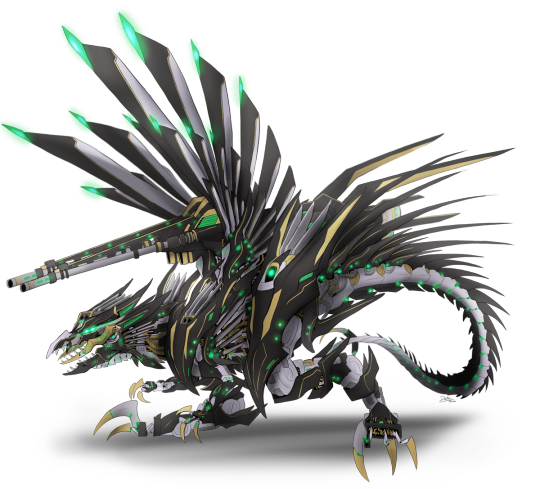
HEMLOCK. Varies between going by “he” or “she” or sometimes “they”. Thought patterns generally described as serpentine and sinuous. Considered to be the biomech with the most developed sense of humor, though biomech standards for “humor” are very low indeed. Definitely the most prone to trickery. Weaponry includes:
Mouth cannon. Mostly intended as a short-fire backup weapon.
Acid spray. Located in the two “spikes” pointing forward on either side of Hemlock’s jaw. As the name might imply, they’re capable of firing compressed streams of acid of sufficient strength and composition to melt armor. Has what is described as a “startling” amount of range by most pilots.
Back cannons. Located on Hemlock’s back, either side of midline. Also contains Hemlock’s main thrusters. Fires either physical shells or energy/aether depending on pilot selection. Used as Hemlock’s main guns, and are considered fairly powerful (though they pale in comparison to, say, Morrigan’s).
Overall, Hemlock is intended as a more stealth-oriented biomech, capable of speedy but short bursts of movement in order to greatest facilitate ambushes--usually of a physical sort. Hemlock also has an optical cloaking ability that, while incapable of making such a large machine invisible, does disrupt the biomech’s outline so much as to make visual firing on it rather difficult. It also heavily disrupts non-visually-based methods of targeting.
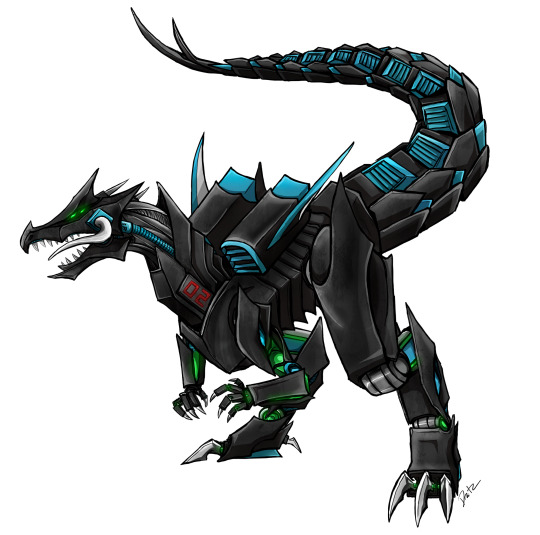
LEVIATHAN/”NIGOKI”. Name varies slightly depending on ‘verse. Second of two prototype-level biomechs. Has no preference for how to be referred to. Significantly more “alien” in thought pattern than the later production-type units, who were deliberately built to be less intensely intrusive; tends to project single-word thoughts at most, preferring to project whole concepts instead. Most infamous for supposed “soul-stealing” of its pilots (and in one ‘verse is actively fueled by half of a long-departed soul, forcibly attached to the biomech through foul magic). Personality is best described as varying degrees of rage and anger, and rarely deviates from this. Weapons include:
Mouth cannon. Main weapon. Can be adjusted to fire wide sprays of energy/aether or single more powerful beams. Curiously, both prototype biomechs’ energy/aetherial usage takes a brilliant orange color.
Hind leg claw. One on each rear leg, behind the foot. The physical claw can, of course, be used for gouging and slashing, but can also channel energy/aether into a vicious blade-like protrusion to better hack through shields and armor.
Energy/aether manipulation. Unlike most biomechs, both prototypes are capable of utilizing energy/aether to create various offensive constructs, though they’re typically only intended for use in close quarters combat (and take the form of blades, claws, fangs, etc). While in use, however, the otherwise incredibly powerful shields cannot be utilized (with the sole exception of when this energy/aether is used to create wings).
Telepathic offense. Also unlike most biomechs, the prototypes are capable of using their telepathic abilities as a weapon, instead of just as a means of communication with their pilots. Most dangerous to those already sensitive to such things, but even the telepathically insensitive can sustain damage from a concentrated enough assault, barring intervention from another source (such as another biomech, magic, specially-designed tooling, etc).
Leviathan/Nigoki serves mostly as a proof of concept for the biomech design, and most ‘verses attempt to avoid using either prototype whenever possible due to the biomech’s propensity for flying into berserk rages.

SILVARRE/“SHOGOKI”. Name varies slightly depending on ‘verse. First of two prototype-level biomechs. Has no preference for how to be referred to. Significantly more “alien” in thought pattern than the later production-type units, who were deliberately built to be less intensely intrusive; tends to project single-word thoughts at most, preferring to project whole concepts instead. Unlike its brother, however, Silvarre/“Shogoki” almost never shows any extremes of emotion, only reacting strongly to any perceived danger to its pilot—even when said pilot is outside of the cockpit, which makes Silvarre/“Shogoki” rather dangerous as a war weapon even to its own side, given its idea of “danger” to a person can be significantly less qualified than an ordinary human’s. Weapons are identical to Leviathan/“Nigoki”s, and include:
Mouth cannon. Main weapon. Can be adjusted to fire wide sprays of energy/aether or single more powerful beams. Curiously, both prototype biomechs’ energy/aetherial usage takes a brilliant orange color.
Hind leg claw. One on each rear leg, behind the foot. The physical claw can, of course, be used for gouging and slashing, but can also channel energy/aether into a vicious blade-like protrusion to better hack through shields and armor.
Energy/aether manipulation. Unlike most biomechs, both prototypes are capable of utilizing energy/aether to create various offensive constructs, though they’re typically only intended for use in close quarters combat (and take the form of blades, claws, fangs, etc). While in use, however, the otherwise incredibly powerful shields cannot be utilized (with the sole exception of when this energy/aether is used to create wings).
Telepathic offense. Also unlike most biomechs, the prototypes are capable of using their telepathic abilities as a weapon, instead of just as a means of communication with their pilots. Most dangerous to those already sensitive to such things, but even the telepathically insensitive can sustain damage from a concentrated enough assault, barring intervention from another source (such as another biomech, magic, specially-designed tooling, etc).
Back spikes. Located either side of midline, three to a side. Can be superheated to cause immense slashing damage.
Nose spike. Located on Shogoki’s snout. Can also be superheated, but is intended for stabbing over slashing.
Silvarre/“Shogoki” is mostly meant as a proof of concept for the biomech design, and its usage is also avoided wherever possible in most ‘verses due to its unpredictability.
===
All art here by the lovely @saintgale! Thank you again, for finally bringing these guys to life in visual art. <3
#; headcanons#please note i don't claim to be /original/ just /having fun with it/ lol#just in RP stuff or fanfic or whatever#so yeah you could probably play 'spot the giant mecha stuff Merry likes' here :P#also: i can't guarantee that ALL these guys will eventually show up here in my ffxiv stuff...#but at least a few of 'em likely will :Dc#ol' Legatus Merceus never intended to ONLY have one ''Weapon''#especially not where the whole Garlean civil war thing is concerned#he knew about the VIIth's shenanigans with THEIR Weapons after all...
6 notes
·
View notes
Text
Antminer S19 Pro

Bitcoin Mining in the United States: A Successful Business
The last few days of 2013 weren’t precisely kind to Bitcoin. China didn’t seem to want to help the crypto-currency industry grow and soon enough the country’s central bank blocked financial institutions and payment companies from handling Bitcoin transactions. Of course, this block is a true reflection about the worry the digital currency poses to China’s capital controls and financial security after a surge in trading last year made the country the world’s biggest trader of Bitcoin, according to Asia’s most popular exchange, BTC China.
However, things seem to be working the other way around in the United States. Businesses in this country want to help the prominent digital currency and the price has gone from a low of $480 in late December to $925 in the United States today. Bitcoin mining hasn’t been a walk in the park the last few weeks as miners have feared a meltdown could take place at anytime. However, the vast majority of supporters have tirelessly argued that Bitcoin is impossible to fully ban, since it exists as a decentralized network of transactions.
Soon after the San Francisco based company Zynga, the leader in online social games, announced they would be accepting Bitcoins as a form of in-game payment, the crypto-currency’s value began to climb. Other company’s that have also taken to Bitcoin include Virgin Galatic, OKCupid, WordPress, Reddit and many others. This is most likely going to become a trend for U.S. based company’s were businesses may begin to use Bitcoin to categorically attract a key consumer base. mining with Antminer S19 Pro

AriseBitcoin: The Bitcoin Awareness Campaign
AriseBitcoin is a new company that is ready to promote the awareness of Bitcoin to the general public by using different marketing projects in hopes of spreading the word about the crypto-currency to the entire world. This organization aims to educate new and existing users in order to encourage a faster appreciation and use of Bitcoin. Arisebitcoin has decided to to kick off its very first Bitcoin awareness campaign in the city of San Francisco.
Created under the name “Hello San Francisco, Hello Bitcoin” this project is self-funded and was designed to introduce users in the bay area to the world of Bitcoin. This campaign will also help existing users gain more information that perhaps they weren’t aware of. Arisebitcoin’s Bitcoin campaign officially began 27th December and will last for one month. The team will be putting up 40 posters over the next few days and will likely put up 40 orange billboards measuring 10 x 22 feet across. The advertisements will be placed in different places ranging from South San Jose to San Pablo.
According to AriseBitoin: “We live by the motto go big or go home and look forward to proving this to not only the current bitcoin community, but to the world. Use Antminer S19 Pro for mining
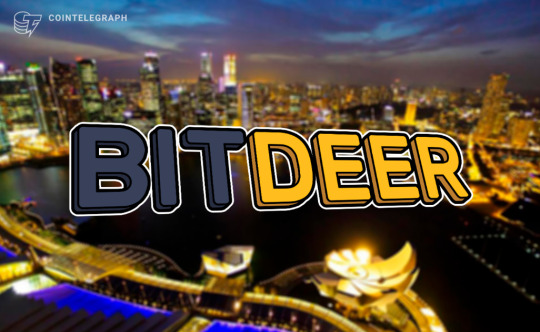
Indonesia Opens New Bitcoin Exchange Service
Despite Indonesia being the world’s fourth-largest country by population the Bitcoin market is not big by any standards. However, Bitcoin seems to know no limits and has no reservations. News has emerged that a bitcoin exchange service has opened in the Southeast Asian nation. Bitcoin.co.id is not the first Bitcoin exchange platform as artaBit and tuker.in have already been in business for some times now but not fully functional. In other words, these existing exchanges allow for users to buy and sell the currency, however the prices are fixed by the sites.
According to local resident Ericson Pasaribu, as of right now these platforms have functioned more like money changers instead of exchanges. They exchanged the local Indonesian rupiah currency (Rp) for Bitcoins but at a rate fixed to those of platforms such as Mt. Gox and Bitstamp, with an added premium. Bitcoin.co.id suggested buying Bitcoins at Rp 7,139,000 ($584.90) each or to sell them for Rp 8,166,700 ($669).
In addition to these web-based services, LocalBitcoins, known as the most hassle-free platform, is one of Indonesian bitcoin enthusiasts favorite exchanges. Pasaribu also said that these localized services are needed in order to raise Bitcoin’s popularity and hence increase the number of coins in Indonesian circulation. Some of the other more international and more prominent are difficult to access from within the country and sometimes new accounts took too long to verify. As of now, Bitcoin.co.id’s has a slower processing time but this is surely likely to change in the very near future. for mining best hardware is Antminer S19 Pro .

Distribution of Bitcoins: Bitcoin Mining
Bitcoin was created back in 2008 by anonymous programmers –more specifically, the mastermind and original idea behind this project is credited to Satoshi Nakamoto. This crypto-currency is reproduced by a network of users with the help of powerful computer processors and hardware. This method is known as “Bitcoin mining.” The initial open-source program estimated that only 21 million coins would ever be created which ultimately lead to a great deal of speculation that has made the price of one single Bitcoin sway from more that $1,000 to a much lower amount in just a matter of days.
Bitcoin continues to be a truly revolutionary idea. When programmers came up with the mining process of Bitcoins as a way to validate transactions and also reward early adopters really gave the digital currency validation. This helped make the network even stronger as it distributed the coins across the most interested individuals. The Bitcoin mining method distributes coins on the network to the person that presents the solution first. The moment the Bitcoin world started to get competitive is when the mining pools begun which allowed multiple users to work together to mine. This way, the pool actually presents the winning solution to the entire network and once the the reward is received it is evenly redistributed to everyone in the pool.
In addition, the Bitcoin mining system is designed so that the work required to find new coins rises at a steady pace as each coin is uncovered. According to a statement by ABC News this makes Bitcoin’s growth rate, also known as inflation, steady and predictable. Antminer S19 Pro is best hardware for mining.
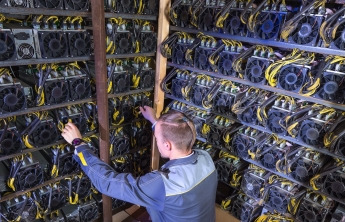
Value of Bitcoins Free Falls After China’s Questioning
Bitcoins are rapidly free falling below $700 – down from just over $1,000 earlier this week – after the Chinese government began their questioning on the legal status of the crypto-currency. According to a joint statement issued by several Chinese official bodies, including the People’s Bank of China, Bitcoins can not be considered a legit currency and are not to be used as a form of payment by any businesses, merchants or financial institutions.
However, Bitcoins have grown so much in popularity during the past few months that many wonder if this statement is to be fully trusted. The fact remain that thevalue of Bitcoin collapsed from $1,216 to $870 on the MT.Gox Bitcoin exchange. Earlier this weekend, one single Bitcoin’s value went from $1,045, before dropping more than $300. In a matter of minutes, the price of Bitcoin went from just over $700 down to $660 – and this trend is going back and forth as it’s expected. In addition, several European nations including France have also started noticing the actual importance of the virtual currency. The central bank of this nation has warned investors that the unregulated currency could very well mean future financial and legal risks.
However, there are many who are behind the Bitcoin industry and have faith in just how strong and secure the currency really is. Just recently, analysts with Bank of America’s Merrill Lynch issued a report that states that the virtual currency is very likely to become an extremely important tool for those purchasing products online. Analysts agree that Bitcoin has everything it can possibly need and want for a continuous growth. In addition, bitcoin mining and the production of the currency is safe, secure and has great potential for the more computer oriented specialists. for best result use Antminer S19 Pro
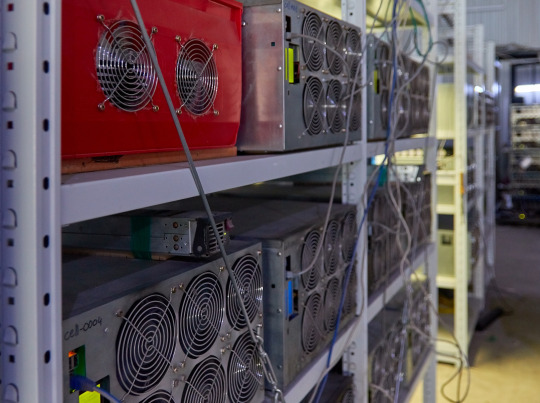
Bitcoin Education to Come By Way of “Idiot’s” Book
Gustaf van Wyk, an Australian who is obviously very enthusiastic about the possibilities Bitcoin has to offer, puts his best foot forward to illuminate those who need a little extra help with The Idiot’s Guide to Bitcoin, which is available primarily through his own website.
The guide is quite comprehensive when it comes to introducing Bitcoin to the beginner, and the timing couldn’t be better, as it has burst into mainstream acceptance and been the subject of much in the way of media coverage. There are a lot of people making their move in Bitcoin, including the Winklevoss twins, who are trying to start an exchange-traded fund in an attempt to catapult this currency to a new level.
This is not a book about that kind of thing, however; it is necessarily aimed at people who are considering speculative investments in Bitcoin, or those who are looking to launch a start-up dedicated to the virtual currency. It is more for the consumer, who will use it as a medium of exchange, because the author feels that is the best way for the Bitcoin economy to grow.
According to van Wyk, “…we can take a significant stand against the fight that Bitcoin will have to inevitably endure before it can truly change the world.” That’s some very high-minded stuff. for mining best hardwre is Antminer S19 Pro
There are some very difficult parts of the whole Bitcoin process that van Wyk has to cover, and in that way it requires some artful simplification of the technology that surrounds the protocol, from mining to establishing a wallet to obtaining Bitcoin through other means to making purchases with it online.
The author reports that he has received quite a few favorable reviews. And why wouldn’t he? This has been a very strong educational tool, and we all know that this subject can be a very difficult one to explain to the layman, creating a need for a book of this nature.
This book is priced at $7.77 in USD, which is also 0.1 BTC, and comes with a 100% satisfaction guarantee.

Matonis Takes Over as Exec Director of Bitcoin Foundation
There has been something of a change at the top of the foremost advocacy group for Bitcoin.
Jon Matonis has recently been named executive director for the Bitcoin Foundation. Is that a big step forward? Well, Peter Vessenes, who is the outgoing director, feels as though Matonis’ “work experience and passion for Bitcoin will combine into something awesome” for the organization’s efforts.
Vessenes says that he is going to concentrate on what he thinks is more suited to him, which is “strategizing, building relationships, fundraising and speaking.”
Matonis describes himself as being “focused on expanding the circulation of nonpolitical digital currencies.” He has been a financial executive for a number of companies, and has also been on the Board of Directors for the Bitcoin Foundation from its inception. He is also a tech contributor to Forbes magazine and is one the board of Tradehill, founded by Jared Kenna, which was the first established U.S. Bitcoin exchange platform.
He also had an eight-year tenure as the Managing Director for the Lydia Group, which involves itself with consultation in a number of different areas, including digital currency, bitcoin brokerage, casinos and betting, payment processing and more. use for mining Antminer S19 Pro
Matonis will dedicate some of his focus to making Bitcoin something with more of a worldwide reach, and wants to move quickly as he is looking to be strong, Toward that end, he is intent on being inclusive of what he calls “the various constituencies within the global bitcoin community.” And he realizes that since the majority of the organization’s membership is based outside of the United States, the focus and activities of the B.F. need to reflect that. For example, he intends to hold major Bitcoin conferences outside of the country, although with meetings that have taken place recently in London and Buenos Aires, it appears that kind of thing is already starting to happen.
He concedes that there are “institutional forces opposed to unfettered Bitcoin growth.” And he will continue the organization’s aggressive stance when it comes to legal defense of bitcoin usage. Specific committees have already been set up at the Bitcoin Foundation to address some of the more pertinent issues facing the protocol / currency.

Bitcoin as Hedge Against Inept Governments? You Bet
What are some of the virtues about Bitcoin that have been playing out around the world?
Well, one of the things is that citizens in countries where inflation has completely taken over, and where government decisions and/or regulations have done great damage to economies, Bitcoin can serve as a useful hedge due to the fact that it is not only not controlled by a government that could prove itself to be inept, but also that it is in limited supply.
At a Meetup in San Jose that was conducted a few weeks ago, Wences Casares, the CEO of Lemon Wallet, a phone app that allows customers to digitally store cards of all kinds, including credit cards, has indicated, with much first-hand knowledge (as someone who grew in Argentina) that people in that country are starting to turn to Bitcoin as a way of literally protecting their savings from being seized or ruined in one way or another by the government.
These are not tech-savvy people, as he is very quick to point out. But they have seen the extreme volatility that has been the result of regimes and monetary policies, and they are not hesitant anymore to use any means at their disposal, whether it be computers or phone apps they can download on what he describes as “old Android phones” to acquire units of the currency.
Who trusts banks? Who trusts governments? A limited number of people on can be assured. That provides something of a built-in audience for Bitcoin.
Of course, what is also appealing to citizens of the many countries who, like Argentina, are experiencing unrest and instability in their economic system is the fact that Bitcoin allows for much more of a uniform and universal trading platform than anything else. And another thing to keep in mind – something that is in no way insignificant – is that Bitcoin allows for the transactions to take place peer-to-peer, which makes all the financial sense in the world to the parties involved because they don’t have to sustain the fees they might otherwise. Best hardware for mining is Antmining S19 Pro
This suitability to the international marketplace is what will make Bitcoin a very hard thing for governments to beat down, whether it is in direct competition with them or not.

Bitcoin Miners Compete, But Also Work Together
Folks like to mine bitcoins for a number of reasons, and regardless of what their specific reason is, no one can really blame them. Obviously, anyone who has gone out and purchased special equipment for the purposes of mining is desirous of bringing about a result. That result is to solve blocks and put bitcoins into their wallet, from where they might be sold. Profit is the goal for the most serious miners, and they are confident that they are dealing in a currency that has a very bright future, because they are expecting that their value, relative to other currencies, is not only going to hold, but also go up.
However, beyond those financial motivations, there are other reasons why people get involved to the extent they do. It is conceivable to say that their interest is altruistic in a sense. There is a certain attitude of cooperation that pervades the entire bitcoin experience. And we say that even though the pursuit of bitcoins itself is individualistic, capitalist, independent, competitive – even opportunistic. They can put all of that aside for the greater good. You see, they realize that the stronger the network, the greater the value in the overall product. And when there is more value in the product, then everybody who deals in bitcoin is better off. And, we might add, a residual, though not inconsequential, effect of this is that the bitcoins are going to be worth more money. best mining hardware Antminer S19 Pro
It makes all the sense in the world, of course, and it is a ruling principle of all economies. Remember always that bitcoin is an economy unto itself. You can visit exchange sites and you will see the value of one unit of bitcoin measured against units of other currencies such as the United States or Canadian dollar, the Japanese Yen, the British Pound, the Euro, South African Rand and other currencies. Because it can be exchanged, there is an inherent value, and that means something to all the people who have it.
Those who have bitcoins are very hopeful that they will be able to retain some real value, and in fact, hope to see an appreciation in that value, as time progresses, especially since there is going to be a limited amount available. That differs from the U.S. dollar, which has seen massive infusions at will in the past, thus creating inflation. Bitcoins have a better chance at maintaining some value.

Bitcoin Mining Brings Technology to the Fore
Are you a fan of technology? Then you may like the idea of bitcoin mining very much. Not only does it involve cutting edge computer action, including putting together an ensemble of equipment that is second to none, but there are constant innovations in terms of the hardware that is required, and that is something that is always going to be extremely exciting.
There are a lot of technological innovations that are working at once when you look into this world. There is a tremendous demand for database, of course, and the kind of activity that must be undertaken during the process is something that obviously demands a tremendous amount of computing power; so much so that it is not unusual at all for teams of people to get together and combine their resources, all working toward the common goal, which is bitcoin mining, of course. Antminer S19 Pro

When people are fully engrossed in this whole process, it is absolutely imperative that they stay on top of everything that represents a technological advancement. The reason for this is that when folks aspire to do bitcoin mining successfully, and at a high level, they know they are competing with others to “get there first.”
Loads of people enjoy it, however. There is something very different about bitcoin mining, because at the end there is discovery, somewhat like a gold strike, that will ultimately reward those who succeed at it. As the hardware has now accelerated into the ASIC stage, it is literally flying like a jet to the stratosphere.
9 notes
·
View notes
Text
The 3 Act, 9 Block, 27 Chapter Plotting Method
There are countless ways to structure your story. There’s the general plot structure (exposition, rising action, etc.), the hero’s journey, and three-act structures—but do you really know how to put together a plot and put it into action?
The 3 Act, 9 Block, 27 Chapter plotting method is an excellent resource for both plot and pacing, and I use it for almost all of my projects. I’ll review it here and give you an idea of what it is, when to use it, and how to put it into action.
What is the 3 Act, 9 Block, 27 Chapter Method?
The 3 Act, 9 Block, 27 Chapter outline method is exactly what it sounds like: there are three acts, which are divided into nine blocks, which are then divided into twenty-seven chapters. Be Your Own Mentor has an excellent page describing each block and its subdivisions here. I strongly recommend checking out this page, as it explains each aspect of this plotting method in detail.
However, this outlining method does more than just suggest where to put plot-points—it’s also a guide for pacing. Each block should be roughly the same length, which helps prevent your story from getting a sagging middle. This relatively uniform length also allows you to set word-count goals for each section, particularly if you’re aiming for a specific word-count in a project.
For example, in an 18,000-word novella, each act (which I split up evenly—some people prefer to have the second act span from the first plot twist to the second plot twist) should be roughly 6,000 words. With three blocks in each act, this means that each block should be roughly 2,000 words. This allows me to keep an eye on how much I’ve written and adjust my scenes/pacing accordingly.
When to Use the 3 Act, 9 Block, 27 Chapter Method
First of all, this is most useful when you need to fast-draft a clean, tight, and effective story. I use it for all of my ghostwriting work, as it is simple, straightforward, and allows me to both discover and understand my story (and what I’ll need to pull it off) while outlining.
That’s not to say that this method is ill-suited to other projects. It’s actually quite versatile (I’ve gone so far as to merge it with the formulaic structure of mystery novels) and simple to use, once you understand it. Even if you’re a discovery writer, it can be really helpful to keep an eye on this chart and make sure you’re hitting all the beats you need to, and that you’re moving your story forward instead of stalling.
That said, it can be less useful for short fiction. Short stories tend to follow a different structure altogether, with many focusing on a specific scene or mood-related to their premise (although I have, on occasion, seen short stories with full plots), so having a beat-sheet or three-act outline won’t necessarily work for you. Now, you can absolutely take parts of the 3 Act, 9 Block, 27 Chapter outline and focus on, say, only Act II or Block 4 for the duration of the short story—because, as I said before, this is a really versatile tool. Play around with it and see what works for you!
Basically: if you need to know the beginning, middle, and end of your story; need a simple beat-sheet for your project; or even just want to familiarize yourself with the generalized structure of a long-form story, this is a great resource.
Key Terms
While BYOM does an excellent job explaining the gist of the 3 Act, 9 Block, 27 Chapter outline, there are a few things that may still be confusing if you’re not 100% familiar with all the fancy plot-terms involved. So, before I dive into how to use the 3 Act, 9 Block, 27 Chapter plot structure, I’m going to clarify a few terms that may cause confusion.
Plot Point - You’ve probably heard of them, but I promise they don’t have to be as dramatic as popular media would have you believe. There’s no need for a surprise! The character was dead all along! if it won’t suit your story. Still, plot twists make for a good story. They keep things fresh and interesting. And, this is important, they don’t have to come out of left field. For example, in romance stories, a plot twist could be something like a plot point the main character forgot about coming back to influence their story, or a revelation of an important character’s backstory, secrets, or other important traits. What I’m trying to say is that these should be Big Moments of your story, but they don’t need to be world-shattering. They should feel natural and rewarding to your story’s premise. These should occur at roughly the 25% and 75% mark of your story.
Midpoint - Strictly speaking, this is the middle of the story. It marks a change in your protagonist: where they were reactive in the first half, they become proactive here. They’ve learned about the new world/situation they’re in, and it’s time for their character arc to impact their choices going forward.
Reversal - Here, both the readers and the protagonist see something in a whole new light. This may be caused by a change in circumstances (in a thriller, for example, this may be a trusted ally betraying the protagonist) or by the protagonist’s new perspective shifting the way both they and the readers see the events of the story. To put it simply, this is where something known changes form. A friend turned foe, a job gone wrong, and even a sudden realization that demands the protagonist’s attention all work. This should occur after the midpoint, where the protagonist has changed.
Reaction - You’ll notice that this appears twice in the 3 Act, 9 Block, 27 Chapter structure, and the ambiguous nature of the term may be confusing for some folks. The Reaction is not so much your protagonist’s response to everything that’s happened thus far so much as it’s their reaction to the plot point that occurred immediately before it. How does the protagonist react to the inciting incident (and its immediate consequences…)? How does the Reversal affect their behavior? These are the questions you’re answering at this point in the story.
Action - While the first half of the structure is mostly reactionary, there’s no getting around the fact that a reactionary plot can be boring, even annoying. This is where you show how your protagonist acts under pressure; something Big has just happened to them, and now they need to decide how to proceed with their life. Do they run, or do they charge into conflict? This defines your protagonist at the early points of their arc and serves to contrast their eventual development in Trials and Dedication.
How to Use the 3 Act, 9 Block, 27 Chapter Method
If you haven’t already, I recommend taking a look at BYOM’s break-down of each block. It’s a very useful guide and will give you an idea of how each point ties into the next.
Ready? When outlining, I keep a “skeleton outline” on hand that looks like this:
This “skeleton” allows me to keep track of everything while I put together a plot in another document that will get far messier and harder to keep track of than the clean, easy-to-read skeleton. In the functional outline, I usually mark my actual outlines with the block numbers and goals, as seen in the second image, but that’s largely due to how I structure my Scrivener document after I’ve completed the outline.
After I’ve set up my outline and have my “skeleton outline” (combined with any genre formulas, as with mystery) ready to go, I begin writing the plot. This usually takes me 1-2 days, depending on my current work-load and productivity levels.
As you can see, I’ve blended a few points together (such as in Block 4, where there’s a lot of overlap in the block’s structure) and added several notes to myself while filling out what happens at each point. You’ll also notice that I write more the further I get through the outline—this is partially because I’m getting familiar with the story, and thus have more to say, and partly because there’s more to keep track of as I get further through the plot. (Including b-plots, which I also make note of in this outline.)
The goal here isn’t to map out everything that happens so much as it is to give me an idea of what I want to be doing in each part of my project. At the beginning, I need to focus on the romance, but in Act II I’ll pay more attention to the b-plot. I often jump around on the outline as I figure things out (such as plot twists, as knowing what these are in advance makes it easier to build them up) and add notes regarding characters I need to create, places I need to have descriptions for, and other project-relevant details.
From there, I set up my Scrivener document. As you can see, I combine and separate each aspect of the blocks as I see fit; the ‘27 Chapters’ is more of a guideline than anything else. When working on a project with chapters, I’ll label each scene with the chapter it will go into, but I don’t sort them into chapters until I’m done writing.
You’ll also see that I write a schedule for myself based on a) how much I need to write, b) when I need it done by, and c) how much I’m able to take on. This is my job, so my schedule is tighter than it would be for someone doing this in their spare time. And, while having a schedule is by no means required, it helps when it comes to managing your project and working to its end. I use highlights, labels, and status markers to keep track of my work and let myself know where I am and where I need to be.
Outlining is a really personal thing, as you’re not just putting together the structure for your story—you’re putting it together in a way that makes sense to you. With the exception of clients who request outlines, no one except for me will ever see this outline. Ultimately, the outline is yours, and yours alone.
Find my blog useful? Leave a comment or check out my Patreon for early-access and extra content! Thanks for reading, and happy writing!
#Plot#Outlines#Writing Advice#hgwhhsj i forgot i’d scheduled tis to post here from my website#but it’s here!
19 notes
·
View notes
Photo

I’ve been working on writing reviews to all the books I’ve been reading instead of leaving stars ratings. I started in 2018 and it’s been really useful to leave notes about what I’m thinking (so I know my feelings later on!). Full review below the cut for Red, White and Royal Blue. My reviews may contain spoilers (but only when needed!)
I really struggle to rate or review this book because what I want to talk about it is the larger ideological project this book contributes to. Normally, I'm hung up on the way the book is written - but this is so masterfully written, well-paced, and with a truly robust cast of characters, it pushes me to really want to dig into its context. Before I go too much into my feelings on ideology, I'll just say: if you want a nice, light-hearted gay fairy tale romance, read this book. It's definitely a book aimed at emerging adult readers. However, I feel like reading this book in 2021 gave this book a different context. It's based in an alternate reality US, where the 2016 election was won by the main character's mother. It pulls together the promise of what liberalism says the US should be - rich, multicultural, with people mostly working in politics because they care about making people's lives better. There's a deep hopefulness that the presidency is good - and for me, reading it mid-crisis, I felt very displaced by this. It seems to be a book that embodies those yard signs of "In my America, we... (insert appropriate statements around multiculturalism here). It's the promise of assimilation. This book feels like what I've been told I should want our political project to lead to. I know asking for revolutionary or deep thought is probably more than I should expect from this book! After all, it came out in 2019, before the struggle of 2020 was known. However, it's hard to see the book make nods toward how harmful power can be (the prince doesn't touch his royal money, as he doesn't want the benefits of empire!) but seems to leave the larger questions untouched. I know, I know - it's not meant to be that deep, but books that aren't that deep are some of our strongest ideological tools.
1 note
·
View note
Text
Authority and Responsibility, How They're Related and How They Affect Project Management

Experienced job managers know they accept liability for your own job once they accept the function of manager. They also realize that the absence of power might seriously impede their capacity to deliver exactly precisely the goals and objectives set for your own undertaking. Responsibility is proportional to impacts. Responsibility for job results does not signify they have positioned on the seat before next job if the person they truly are directing neglects, it's a fiscal outcome. They'll have problems from the job through removal or decrease in bonus, a re assignment to a responsible role (using an attendant decrease in wages ), or even dismissal when it comes to advisers. The text between consequences and responsibility will be entrenched running a business. Larger more pricey projects will be inclined to participate more mature job managers along with the result of failure will likely probably be more tolerable. The text between job outcome and consequences are also increased.
What exactly is without my adventure (20 and years since a programme and job manager) is a correspondence between responsibility and authority. Job managers may do a lot of the job preparation without needing usage of jurisdiction. Job managers may be needing some assistance from subject matter experts for a few of the preparation job, even when it's simply to affirm attempt or cost quotes. Larger, more intricate projects generally own more demand of material experts to this purpose that a number of the task is intended with these experts. The power required to acquire and handle the tools required for this particular job will often have the land. It's as soon as the job reaches on the build or execution period that the job manager needs power. They could organize the task, organize the task, and track performance but minus power they have an extremely limited power to be sure the task is done in time with the essential quality.
The greatest, priciest, many complex projects are directed by project managers that hold senior positions within their associations and bring that degree of ability with their own endeavors. Even the Manhattan project, that presented the Atomic bomb during World War II, can be an fantastic instance of such a job and project director. Leslie Groves, who handled the job, was a three star (lieutenant) General. Even the huge bulk of projects that do not fall in the Manhattan job category concerning size are at which the text between responsibility and authority falls apart.
Most projects now are implemented in a"matrix" environment by which the company utilizes job managers to conduct projects and operational managers to take care of people. The matrix environment can be really actually a great fit for the majority of businesses since they've a mixture of operational and job work. The issue with the matrix environment is that seldom do they include a blue print for your division of jurisdiction between the operational and job manager, meaning the job manager has not one of the jurisdiction and the operational manager has all of it out of the resource's view. Organizations using more older matrix surroundings might possibly have taken several measures to eliminate the conditions this division causes, but do the definitions of both the 2 functions include an exact description of jurisdiction. That is most likely also because of the simple fact the HR group performs a huge part in defining authority throughout their coverages and so they are normally behind the curve at adapting their coverages into the direction of endeavors.
Issues begin with the purchase of this challenge team. Job managers are more prone to the exact identical greed and the remainder of the race and also might really like to get a free reign to obtain the most effective tools the company has to offer you. Functional managers, alternatively, have their own operational responsibilities to think about. They'll soon be paid for the funds that they purport into the undertaking however are not usually incented to create certain that their best and therefore are distributed around the job manager. That is due to their operation is quantified depending on the accomplishment in these operational responsibilities. Should they create their finest resources available into the undertaking they could don't deliver to their operational targets and objectives and which might have a destructive influence on their reimbursement. The best way I've found to balancing functional and job demands is to get operational managers whose only responsibility is that your"care and feeding" of funds. As they don't really possess every different operational responsibilitiesthey have been totally absolutely free to estimate the competing demands of operations and projects and make assignment decisions based on their own understanding of what's best for that company.
Issues encountered with team acquisition will disperse during the remaining portion of the undertaking. Assuming duration and effort estimates were predicated on some amount of performance which is more than a number of the gained team are effective at fulfilling, job performance are affected. Figuring out into the job sponsor which performance problems are increasingly now being brought on by underperforming downline might or might not attract relief. The host is very likely to observe your complaint together with scepticism in the event that you did not raise the issue earlier. A inability to carry out the task isn't the sole reason behind poor functionality. Definitely the most frequent cause of insufficient functionality could be that the corrosion of resource time by the job by functional requirements. The requirements might be quite legitimate and also the operational job required of this resource might be the greatest possible usage of this resource to the benefit of the company. It will not help the job manager while he or she's got to spell out poor job performance to those stakeholders. This example is bad enough as soon as the job manager is given notice of their requirement but is worse once they know about this shift after the actuality. The degree of jurisdiction that the job manager was awarded, or at the functional director's understanding of this jurisdiction, will frequently determine whether or not they discover regarding the operational job before or after the actuality.
The opposing side of this tools coin would be that your benefits and recognition which can be utilized to construct team morale. A scarcity of jurisdiction of this type usually has todo with the job manager's capacity to devote money to offer awards or buy every other sort of teambuilding activity. Recognition and rewards are often regulated by HR policy that's why the job manager isn't provided ability to bestow those on worthy downline. The absence of all sorts of funding to get awards would be that the other rationale.
Last, the manager might be contacted to take care of downline whose thoughts is not from the match. They will have the opportunity, experience, and training to successfully execute the job on the degree of proficiency envisioned from the job plans but do not. There might be many different good reasons for this however they often stem out of the resource's devotion to this undertaking, or lack there of. Let us go through the illustration of this process improvement endeavor to exemplify what I am talking. The good thing about this process improvement is that the removal of attempt that can result in job loss (atleast at that section ). Some of those associates working with this job could possibly be the people whose tasks will be expunged; afterall they truly are the topic matter experts in the older procedure. Might it be rational to expect such folks to demonstrate excitement for your own undertaking? Certainly not. Unless the job manager can demonstrate these downline how the job may reward themat least not harm them they are planning to be much committed to the objectives of the undertaking.
The shortage of excitement might not have a thing related to security; yet you will find some of causes of a lack of commitment from downline: jealousy, and the understanding that their desires are served when your job fails, a devotion to a job they perceive as rival, dissatisfaction a pal isn't delegated to the team are only some of their"political" reasons a crew member might not offer the job their very best attempt. Resolving some one of these problems will necessitate that the job manager have a certain level of jurisdiction within the resource. It will not necessarily indicate that they will have hiring and firing ability, the capability to influence their reimbursement could be adequate.
Now I've made the situation to get a power commensurate with the level of responsibility, let us look at a few manners and method of acquiring this ability. I'll begin with covering the people who host endeavors. You ought to hold your job managers in charge of job results; that is their occupation, however it will not seem sensible to carry them answerable for giving them the power to fit with up with the job's aims and objectives and also power is an integral component of the skill. You might help this by arriving at an understanding with your job manager within the amount of authority you are committing them. Working inside the policies ordered from the HR staff, you ought to delegate them with the ability amount you agree that they require. Do not speak in generalities, make certain. The job manager should be aware of very well what their remedies come from case where they will have performance problems with members. The procedure utilized for deciding the composition of the task group must be clearly articulated. How can disagreements over human funds be resolved? Obviously to accomplish that in a means which is reasonable for the company, you are going to have to reevaluate your job contrary to one different projects and operational work of their company. In case the job targets and objectives are high priority, then the undertaking can not be described as considered a very low priority with regards to competing for scarce resources.
Their amount of jurisdiction over the downline, once the team was defined should be clearly articulated also. How can the job manager cope with a group member whose operation is sub standard because they don't really possess the needed knowledge or experience? How can they handle that the team member with got the essential capabilities and experience however, is not doing for another reason? The job manager's ability has to be ascribed in adequate detail to ensure these questions are replied. Delegating authority to the job manager does not need to contravene some HR policy. As an instance, it might be against policy to permit the job manager to fire or hire funds but by which stakeholders, clients among the others, subscribe to performance reviews be certain that the job manager is still a contributor and be sure their inspection is discretionary in view of the quantity of time the resource goes to the job and the job priority. Alternatively some times endeavors are essential enough and HR policies supporting sufficient to justify changing them. You shouldn't be reluctant to assemble political allies and also create the case for shift into HR. You may possibly become prosperous in effecting the shift to your upcoming huge project even though you're not successful making the shift to your one.
The job area the job manager will require jurisdiction to get is rewards and recognition. The job manager will have the ability to pronounce a rewards and recognition programme to your own undertaking, or how they'll utilize present comprehension and rewards ventures. Be sure they will have enough ability to manage the programme. This will signify that a funding, ordinarily. Workout the way you are going to make the cash available if needed in scenarios where it's not possible to provide the job manager any registering ability. Last, be open to get involved in awards ceremonies or team development tasks. I have not managed almost some other patrons who did not like these occasions after that they were subjected in their mind.
Job managers who've patrons who've did not learn the aforementioned, or even that are uncomfortable taking the initiative on you, need to initiate the dialog themselves. When you have defined the degree of authority that you need in-detail create sure it's recorded. If your jurisdiction isn't in writing anywhere, that you never possess it. People's memories being exactly what they are, that the better understanding that you possess of this power you've got will change in the host's and that gap is only going to expand as time continues by and memories stinks. Bear in mind that the power you are awarded isn't plucked from nothing, it's jurisdiction your host has (or every further senior stake holder ) they assign for your requirements personally.
Your power ought to be recorded from the Project Charter. The degree of detail need be no more compared to the remaining part of the journey; you could leave this to certain tasks or intentions. It ought to really be spelled out from generalities such as"the Project Manager has the authority to participate in the selection of the project team","the Project Manager will evaluate members of the team and these evaluations will be used in performance reviews", or even"the Project Manager has the authority to address performance issues". Specifics could be abandoned before job progresses into the main point at which jurisdiction becomes necessary. As an instance, you'll be able to request a email from the host in progress of team acquisition specifying the way that decisions will be reached on individual associates and the disputes will be managed.
Authority is similar to a muscle: it'll atrophy if it's not properly used and wont be around as it's needed. Your host has given you ability so you may put it to use in order to reach your project's aims and objectives therefore that you ought to not don't reach them as a result of a deficiency of jurisdiction unless you had been denied it. Which usually means that if downline refuse to comprehend your ability to guide their job you must put it to use in order to inflict your will in it. Do not confuse the imposition of one's leadership without misuse. You abuse your power once you use it for purposes aside from the achievement of their job's aims and objectives or any time you show favouritism damaging rewards or consequences. Stay away from abusing your power in any way costs, however maybe perhaps not at the price of neglecting to practice it. To guarantee you stay away from abusing your power it is really a fantastic idea to own your own HR company's policies and policies convenient and ensure you are comfortable with them.
Job managers that commence the dialog concerning jurisdiction is going to have the benefit to be in a position to specify the amount of authority that they believe they require. This may be carried out by copying out your authority in the draft edition of the Project Charter or even in another record that simplifies it. Avoid being faint hearted here. It's much far better to possess jurisdiction you never desire and do not utilize than to neglect to own it and want it. You shouldn't hesitate to practice an authority that you never need because neither you nor the host foresaw a demand for this. Your host is a whole lot more inclined to forgive you exercising with an ability that contributes to the achievement of your job goal when they truly have been supposed to forgive you for a failure to fulfill with up with the aim.
Nearly all of everything I've said here would employ to job managers that are permanent employees of those associations that they handle jobs for, but think about advisers? These people subconsciously end up at"matrix" surroundings as in associations who are projectized or with a older, recognized matrix structure, they don't really connect with the adviser. Consultants have to be particularly meticulous in outlining their degree of power and in deploying it. Their jurisdiction won't ever incorporate the capacity to shoot or to choose and pick tools when acquiring the team. In the majority they are going to have the ability to employ builders and take part in acquisition discussions for employees in order that they will need to guarantee that they will have a fix which may tackle a insoluble problem having a group member. Remember that whenever you arrive at the job that you're an unknown quantity into your stakeholders. They've experienced exposure for you personally as soon as you interviewed to get the job but you are still an unknown quantity. Once you've experienced the job for a little while you need to really have gained a degree of confidence that'll enable you leeway in working jurisdiction but before then do not make assumptions which will enhance your host.
In the end, in the event you are not able to possess your host delegate the ability for your requirements which you want to succeed, then be sure to record that very fact. How would you really do this without even insulting your host? Simple, maybe perhaps not needing the ability required to attain project aims and objectives would be a probability to all those aims and objectives and needs to be recorded from the job's risk register. Do not clarify the risks in personal terms; clarify them with regard to what the threat occasion appears like and the probable effect on the job should they happen. A dialog concerning mitigation plans to cover the risk might possibly cause giving one of that the ability. At minimum they should result in a reduction plan that'll lessen the degree of risk. In case everything else fails and there isn't any awarding of identification or authority of reduction plans, the undertaking must accept the hazard. You still have the choice of estimating this risk and also its own approval whenever the risk register is reviewed with all the stakeholders. A word of warning here: the danger identifies a debate between you and your host; tend not to utilize this as a chance to embarrass your host facing their managers or peers.
1 note
·
View note
Text
Trash, Sweeps, and Life Unsheltered in Portland
“I understand that homeless people have it rough, but I don’t understand why they can’t just pick up after themselves better.”
It was a grey and depressing Portland morning in March of 2018, the time of year when people start getting excited about the end of winter, but before the time of year when everyone’s resolve is collectively crushed and we learn to accept to our sunless future. Some coworkers and I had the opportunity to earn some bonus money from our job by spending a few hours picking up trash in the neighborhood around our store.
“I don’t understand why they can’t just pick up after themselves,” said my coworker, as he tried to lift up a wet sock using a trash-grabber.
At the time, I didn’t really have anything to say to him. It was something that puzzled me, too. Walking around that part of town, it wasn’t uncommon to have to cross the street because a camp had completely blocked the sidewalk. Often times, although the tents themselves weren’t in the way, the outward sprawl of car parts, old tarps, abandoned box springs, and bicycles made passage difficult.
As with most of the things that I’ve learned since I first started working with unsheltered folks in Portland, the answer to my coworkers question was simpler and more direct than I imagined. I should have asked, Where are they going to put their trash? And then, who would come pick it up?

This photo is from a 2017 pilot project in Oakland that helped provide large-scale camps with trash service.
For the last few months, I’ve been working closely with a group called The People’s Store. We’re a mobile, pop-up, free “store” that helps unsheltered people get access to the daily care items they need. The things we carry in the store and the services we try to provide are informed by the unsheltered people we serve. One of the things that came up a few times was the need for a way to dispose of trash.
One of our volunteers pointed me in the direction of Metro’s Bag Program, a service our regional government has been providing since 2018. From their website: “Metro's bag program provides people who are experiencing homelessness with a way to dispose of their trash. The program started as a pilot in the fall of 2018 after Metro engaged local government representatives, law enforcement officers, community health workers and people experiencing homelessness to better understand disposal challenges for people living in camps, cars and RVs around greater Portland. In addition to providing disposal options, the program also aims to reduce litter and keep our communities clean and healthy.”
Metro distributes rolls of trash bags to camps around the Portland area, and there’s a phone number printed on the side of the bag that anyone can call to have the bag picked up by the RID Patrol, a task force on illegal dumping. RID Patrol employee Juan Garcia said in this article that “people living outside often offer to help him clean up. He recalls one site where a man was sweeping with a broom he'd made himself out of branches from a bush. ‘And he was literally making piles of rigid plastic and metal to recycle,’ he adds.
vimeo
For more info on the Bag program, check out this video, created in partnership with Metro and Outside the Frame, a group that provides youth experiencing homelessness a way to tell their stories through the medium of documentary film.
The same article quoted Richard Catlett, an unsheltered person helping Garcia clean up a camp on 82nd avenue. “‘Homeless people aren't trash. We aren't worthless,’ he said as he pointed to some garbage on the ground. ‘This is a by-product of how we're forced to live.’
Beyond barriers to trash disposal faced by unsheltered folks, Catlett is right to highlight the fact that life on the streets often involves many single-use, individually packaged, and non-durable or repairable items. When I first started volunteering at Street Roots, I noticed the popularity of the styrofoam and plastic Cup Noodles ramen soups. I studied sustainability in college, and there was something deep in my brain that felt bad about handing out single-use styrofoam containers, along with single-use plastic utensils, knowing they would end up in a landfill in short order. However, who am I to begrudge someone their only calories for the day because the packaging isn’t a suitably sustainable item?
In an attempt to distribute the most goods to the greatest number of people, many of the items that folks donate or distribute to unsheltered folks are cheap, bulk buys. It’s an honorable goal to be able to distribute 50 backpacks instead of 10. However, when these items can’t stand up to the rigors of life outside, they inevitably end up as trash. Even if repair of these items is possible, it’s often not worth the time nor the money to purchase the required supplies. Coupled with the fact that there aren’t many opportunities to dispose of trash items, these things pile up.

This flyer from Portland advocacy group Stop The Sweeps provides critical information about the city of Portland’s campsite sweeping policies. One of the criteria used by the city to determine which camps to sweep first is “Has significant garbage or debris.” Without providing a robust system for trash disposal, it’s not clear how this is a fair qualification for determining which camps to sweep.
However, there’s a parallel kind of logic present in the nature of sweeps themselves as a response to homelessness. The city provides few opportunities for unsheltered people to dispose of their trash, and then judges them based on their ability to keep their camps clean: The city provides few opportunities for people to access the supportive housing, and then disperses camps of people who already had nowhere else to go.
In an article on the Metro website, Solid Waste Planner Rob Nathan was quoted as follows: “We keep hearing from our partners that the more people are moved, the harder it is to provide them with transitional services, healthcare and housing—all those things we need to get people off the street. Our partners are really excited about this (the bag program) because they see this as a tool to help keep people stable, in one spot, and complained about less.”
In Portland, we’re incredibly lucky to have groups like Metro providing creative solutions to these problems with programs like the Bag program, and to have groups simultaneously creating low-barrier jobs and provide trash services through Central City Concern and Clean Start PDX. Programs like the bag program are a critical step in making sure that people can avoid getting swept and can experience the stability required to rebuild their lives. It’s clear that unsheltered folks want to help keep their camps clean- they just need the trash bags and trash service to do it. Programs like the bag program provide this support and help close the gap between the services housed people take for granted and the services unhoused people really need.

This photo is from a Street Roots article in the winter of 2019, when ODOT announced it was ramping up sweeps on ODOT property.
A few weeks ago, I was driving through a large camp in Laurelhurst Park, after making a supply drop for The People’s Store. As I drove by, I saw a woman using a broom to sweep off the sidewalk in front of her tent.
A few days ago I learned that the Laurelhurst Camp would be subject to a sweep. Notices were to be posted shortly, and folks would have 24-48 hours notice to bring their camp into compliance with city policy on trash, social distancing, and other criteria.
During the coronavirus pandemic, the CDC recommends that cities not clear encampments, as this can cause people to disperse throughout the community, making any kind of Covid-related contact tracing even more difficult. The CDC also recommends that cities ensure that nearby restroom facilities are available to unsheltered folks 24/7, and are “stocked with hand hygiene materials and bath tissue.”
What would Portland look like if we followed this recommendation, providing all of our community members with basic necessities like access to running water and trash disposal?
Sources, Inspiration, Further Reading:
https://www.oregonmetro.gov/news/bags-provide-garbage-service-those-without
https://www.oregonmetro.gov/news/garbage-pick-shines-light-stories-we-can-t-see
https://www.oregonmetro.gov/tools-living/garbage-and-recycling/report-dumped-garbage/bag-program
https://www.streetroots.org/news/2019/01/11/camp-sweep-comes-city-takes-over-odot-land
1 note
·
View note
Text
How to Generate Business Ideas Through The Brainstorming Technique

Generating promising business ideas isn't easy, especially if you're alone and you do not know how to start doing it. However, through brainstorming, you can come up with great ideas that could lead you to begin a terrific business. Brainstorming is just a method of producing a group of individuals to consider something the exact same time, usually with a goal of solving a problem or producing good thoughts.
If you're really stuck and you can't generate decent business ideas independently, you can engage your colleagues to encourage you. Do not forget that the combined brainpower of a bunch of individuals, coming together to deliberate on a specific problem, can spark off ideas and solutions better than you working independently. I'd so like to share with you some of the suggestions on ways to use brainstorming to create good business ideas.
1. The first issue would be to scan the environment to identify the issues that will need to be solved along with the demands that people have. As you're the one spearheading the whole exercise and the principal beneficiary, you should have the ability to pose the problem to the group.
2. Secondly, identify people which are going to be a part of the brainstorming group. The way to identify them all depends on you and the people you surround yourself. The identification method is followed by an invitation for them to take part in the exercise. You may engage your friends; state on Facebook, to take part in brainstorming. You can even carry out online surveys.
3. Get as many ideas as the group could create. The more ideas generated the better for you. No thoughts should be blocked. All ideas should be permitted whether good or bad, whether wise or foolish. All members must be left free to develop ideas which are as funny or as absurd as you can. Bear in mind that all ideas are great because from the poor or silly ideas, good ones can be found. In any case, the term"GOOD" makes sense since there's also"BAD".
4. Respect all thoughts from the folks in the group. By regard, I mean you need to respect them as precious and you should therefore avoid criticizing them or assessing them. It can spoil the entire process and people become uncomfortable distributing openly what they have in their thoughts. In the brainstorming stage, all ideas are equally valid. It is therefore a good practice to keep enjoying each and every member of this group that generates a notion.
5. Do not repeat ideas previously mentioned. While I say this, I don't mean that if one repeats an already mentioned thought, you stop them. It will sound as if you are just too much restrictive. And that doesn't bring out the expected benefits. What you need to do, when somebody repeats an idea, would be to use the identical notion to jump into other new ideas. You use it as the foundation for to other new ideas.
6. Clarity is important in creating business ideas. Ideas shouldn't be complex and detailed. Individuals shouldn't inform winding stories that end up making people confused and eliminate time. Members need to be properly guided to precisely and concisely bring out their thoughts.
7. Avoid being judgmental. When you do that, it will obviously have a negative effect, especially on shy individuals or on those that are not knowledgeable about the thought of letting their thoughts flow and expressing them openly. You'll be spoiling the entire procedure.
Finally, I want to remind you that in the event you've been finding it hard to generate ideas to begin a small home business, consider applying this technique of brainstorming. It can work wonders for you. Don't suffer alone when you're surrounded with a number of resourceful people and when you can also get them over the internet. Wish you good luck!
Good Business Ideas For The Home Business Entrepreneur
The notion of creating an income from home is very attractive, especially when you've got the drive and ambition to start your own business. However small or large your entrepreneurial dreams, there are loads of great business ideas to be explored.
Forget the"Get Rich Quick" schemes or the promises of steady income for very little time commitment and"all you need to do" is invest in an upfront program (if something appears to be too good to be true, it likely is), and concentrate on making your own business doing something you love. When there are great business ideas which have made money for some you want to discover a business that excites and energises you. With the proper motivation and a solid business idea you will have the tools for success, and the ability to continue with your business over the long run.
Superior business ideas for home business entrepreneurs fall into three broad classes:
1. Virtual Services
With the gigantic growth in outsourcing of certain tasks or tasks, there are lots of opportunities to provide your services virtually. This means that you can work at home and provide services like admin, writing, marketing, design, information technology or social media to businesses. Either on a project basis or as their digital PA (personal assistant), marketing officer or social networking expert.
As a digital PA you'll handle all of the tasks a PA would, logging costs into a spreadsheet, booking trips, organising calendars, booking training, preparing materials for presentations and events, but based at your home.
With systems and tools like google Docs, Dropbox and other online sharing programs, it is easy to share information and supply spreadsheets, documents and reports remotely to your customers.
As a freelance writer you may offer to write reports, articles, edit articles, post blog comments, manage forum marketing, provide blogging, tweeting or HubPages content, the choices are limitless.
In case you have knowledge of SEO (search engine optimization ) you can offer a service building traffic to your customers' sites and blogs.
Locate clients by promoting your services on a Facebook fan page and by contributing to relevant discussions on Facebook, forums and blogs. Or you can discover freelance work through websites like Elance, Guru or PeoplePerHour.
2. Local Services
Use your skills and expertise to provide services to local businesses. In case you have even the most elementary marketing, online or social networking skills you can offer to be their marketing or social networking expert. Charge on a per job, hourly or monthly retainer speed, depending upon your regional market and the experience you're offering.
Many regional businesses are great at what they do but struggle to find new customers and market their business effectively online. Stop in and talk to some regional businesses and show them the way to help them get more customers, by enhancing their online marketing or social websites.
A good suggestion is to get the regional newspapers, church, school and parish newsletters and determine which firms are advertising. Contact them and talk to them about ways to help them get more business, or spend less.
3. Online Business
Online businesses are flourishing as demonstrated by the explosion in the numbers of individuals online and using Facebook. Home business entrepreneurs are discovering opportunities online like never before. Begin with a hobby, skill or something you feel passionate about and look at ways to generate income from it.
Superior business ideas include becoming an infopreneur. Create information products to discuss your ideas and experiences with others to help them resolve a problem, or fulfill a need. This can be by means of a blog, forum or community site, membership website, ebooks, reports, newsletters or online training.
Information can be given in downloadable formats so clients receive the information they want straight away, and you make money each time your merchandise is downloaded.
An information business isn't hard to set up, low risk and you can test your ideas on a small scale prior to producing more comprehensive products. Promote affiliate products to check your market or make money selling goods on eBay or Amazon.
If you are selling physical products that you may use drop-shipping to automate the fulfilment and shipping of your goods so you don't need to take care of products. The drop-ship company will handle the invoicing, payment and shipping of the goods. All you do is promote the product to the client.
The aim with an online business is to automate as much of it as possible, so you set up the systems and leave them to operate. That way you will have a truly automated business which makes money even while you are sleeping or away on vacation.
I'm a huge fan of small niche websites which you set up and forget. They will not make you rich but you can create as many little niche sites as you like and multiply your income. A niche site will concentrate on solving a single problem for a particular market, such as weight loss, caring for bearded dragons or betta fish, or eliminating acne.
Superior business ideas are all around. Start looking at the possibilities everywhere you go. See what the hot topics are in magazines and newspapers, listen to what people are talking about (or whining they are missing) and begin with your own home business now.
#business#good business ideas#business ideas#online business#business entrepreneur#home business entrepreneurs#generate business ideas#brainstorming business
1 note
·
View note
Text
CGWorld: Interview with Resident Evil 7′s lead character artist
The following is a translation of an interview with Hirofumi Nakaoka, the lead character artist for Resident Evil 7: Biohazard that was published on the CG World website on January 13, 2017.
You can find the original article on the following link:
https://cgworld.jp/interview/201701-capcom.html
Introduction
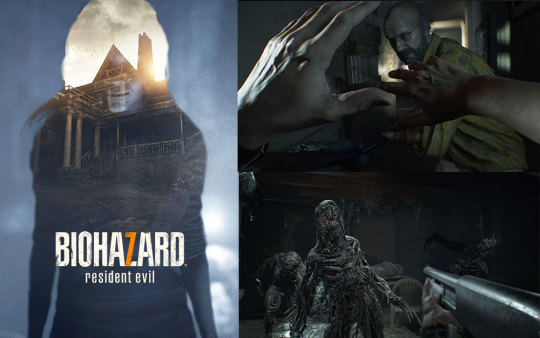
Resident Evil 7: Biohazard, the latest installment in the popular survival horror game series has finally been released. It’s the first numbered title in the series developed natively for current [8th] generation consoles based on Capcom’s in-house “RE Engine”, which also supports VR, incorporating a presentation of fear like nothing that came before. With the entire game being fully compatible with VR, the title is expected to be a spark that will ignite the VR gaming market.
Capcom, the company who developed and published RE7, has established two new local development bases in Osaka with a focus on in-house development. They are aggressively hiring human resources and are expected to have over 2,500 game creators in their employ by the year 2021. Such a company-wide strengthening of its development system is also due to the need for an environment that allows for the creation of more discerning games. We’ve interviewed Hirofumi Nakaoka, lead character artist for RE7, about the human resources and development environment sought by the company.
The Amount of Calories That Can Be Poured Into Each Character Varies

Hirofumi Nakaoka (仲岡 博史) was the lead character artist in RE7. He is a digital artist from Tokyo with 9 years of experience who transferred over to Capcom due to his love for zombies. “I changed jobs during my second year of employment, but I got used to the change pretty quickly.” says Nakaoka. “I don’t really feel any barriers from newcomers or transfers when I look around. I don’t have time to make walls around myself, so people around myself tend to talk with open frankness and we all become pretty close. From a company-wide perspective, only half of our employees are from the Kansai region and the number of foreign creatores are increasing as well.”
What Capcom wants is “a passion for creating games” is the first thing that Nakaoka says in blunt terms.
“As the scale of game development increases, the need to create prettier games that require less rework increases.” says Nakaoka. “However, people cannot control their inner urges, even when they’re receiving instructions from above. There are ideas from all over the place and people who seemingly want to realize them.” As Nakaoka points out, cooperation, character and technology are of course essential, but more importantly it is important for people to have some passion and not be too divided in their jobs.
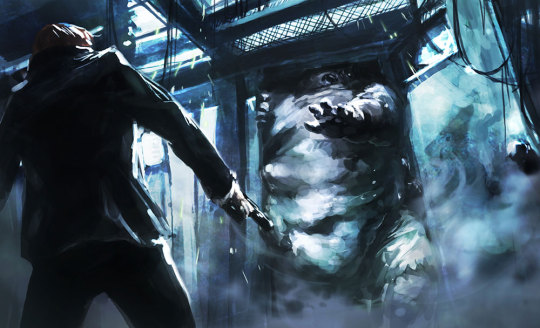
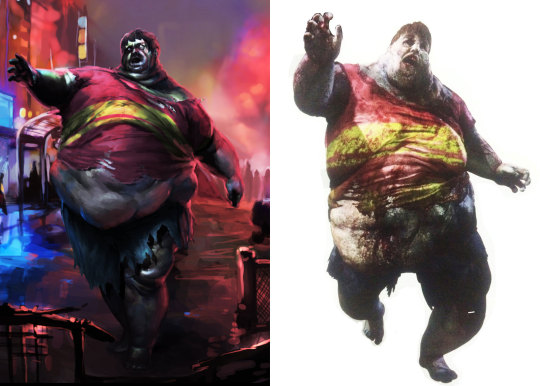
The Whopper made a shocking debut in Resident Evil 6, the previous entry in the series. A morbidly obese zombie also known as the “XL size” within the game. Top: the first piece of concept art depicting a creature that is too large to enter a door. Bottom left: Finalized concept art. Bottom right: Official CGI.
In fact, Nakaoka said that during the development of RE6, he wanted to make a large obese zombie. He was entrusted with the design and modelling of the enemy, which led to the birth of the so-called “Whopper” enemy character.
The Molded, a new creature introduced in RE7, was also a daring new character concept that was created from full-scratch at a time when 3D scanning is becoming more commonplace. “There was no material to use as a reference so we created [the Molded] from scratch. I think that’s what makes our company unique.”
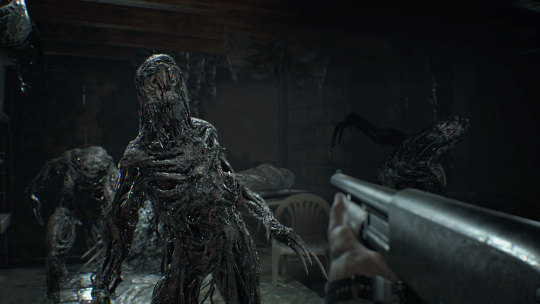
Molded, a new creature that appears in RE7. Creature from complete scratch without any photoscanning. An enemy representative of the game that gave players trouble even in the demo version of the game. “It was a difficult character to create” says Nakaoka. “But as someone familiar with the series’s setting, I think it fits quite well.”
Aiming for video quality that approaches the quality of overseas VFX movies in real-time
Cooperation with partner companies is now required in order to reduce labor cost in the large scale of game development. In response, Capcom has opened two development studios in Osaka City, with plans to hire over 2,500 developers.
“To create a high-quality game, first we need a structure that allows for in-house development. Then we will cooperate on the necessary parts and manage our costs.” such is their policy.
In addition to recent graduates, Capcom is also actively recruiting mid-career veterans, with almost all the job posts available for high-end CGI artists and engineers.
“With the evolution of technology, we’re constantly switching between new tools.” says Mr. Nakaoka. “The RE Team in particular has a work chart that is optimized in a timely matter during development.”
When it comes to modelling, photoscanning is being used more frequently. For example, you can buy a hamburger, break the wrapping paper in a nice way, scan it, fix it and then use it in the game. In turn, if the final data format is preserved, the individuals will have the flexibility to use whatever tools they like.

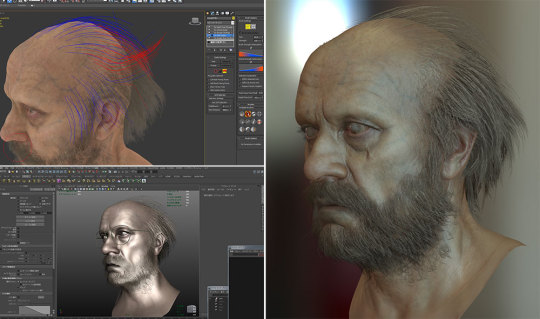
Up to around 12 tools are used to create a single character model.
Upper left: a 3D-scanned model via Photoscan, a program which recreates in high-quality a solid object via photographs taken from various angles.
Upper right: Retopology with Zbrush.
Center left: Hair generated by the Ornatrix plug-in.
Bottom left: Detail fixing with Maya.
Bottom right: Real-time output with the Marmoset toolbag
Job applications from outside the videogame industry are more than welcomed, particularly experience with high-end pre-rendered movies. This is because knowledge in pre-rendered videos from the movie industry is required to create better real-time CGI. On the other hand, even mobile game artists can quickly catch up with the technology and tools if they have a solid foundation. In-house desining meetings and conference briefings are also frequently held and assistance to seminar attendees are also provided.
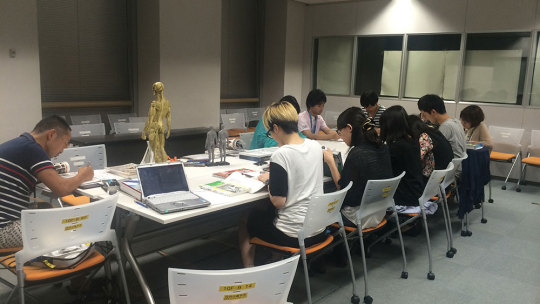

An in-house designing meeting (top), with a guidelines on how to design characters (bottom). Artists recruited from vocational schools tend to have lacking drawing skills compared to their skills with tool acquisitions and game development. For that reason, Capcom often holds lectures teaching their employees on how to draw. In addition, there are other various in-house seminars such as tool studying sessions and conference reports.
One of their features is their emphasis on an employee’s welfare and mental care. A superior takes care of and calls on the assignment of both, projects and positions. On one hand, employees are required to have a regular lifestyle. If an employee wishes to work overtime after 10PM, they must ask permission from their superior. “Despite the flexible workhours, we still value health overall.” says Nakaoka. “Perhaps that’s the one aspect that differs the most from the past.” A passion for creativity and a heart that governs you. Cool games are being created by a group of professional creators with backgrounds in creating not just videogames, but also from the live-action and animation industries.
Text by Kenji Ono
Photos by Yohei Onuma
7 notes
·
View notes